Best Sailboats for One Person (With 9 Examples)
One of the most common challenges of sailing is finding the right boat to sail alone. Luckily, there are some good sailboats out there suited for one person. Let's take a look at them, and find out why they're especially good for single-handing.
In this article, I talk about single-handed sailing and look at the nine best sailboats for one person, ranging from small lake dinghies all the way to comfy cruisers capable of oceanic crossings.
Here are the best sailboats for solo sailing

Jeanneau Sunfast 3200
Beneteau oceanis 62, pacific seacraft flicka 20, tartan 3700, hunter channel 31, j boats 109.
Now let's look at them in detail so that you can choose the one best for you.
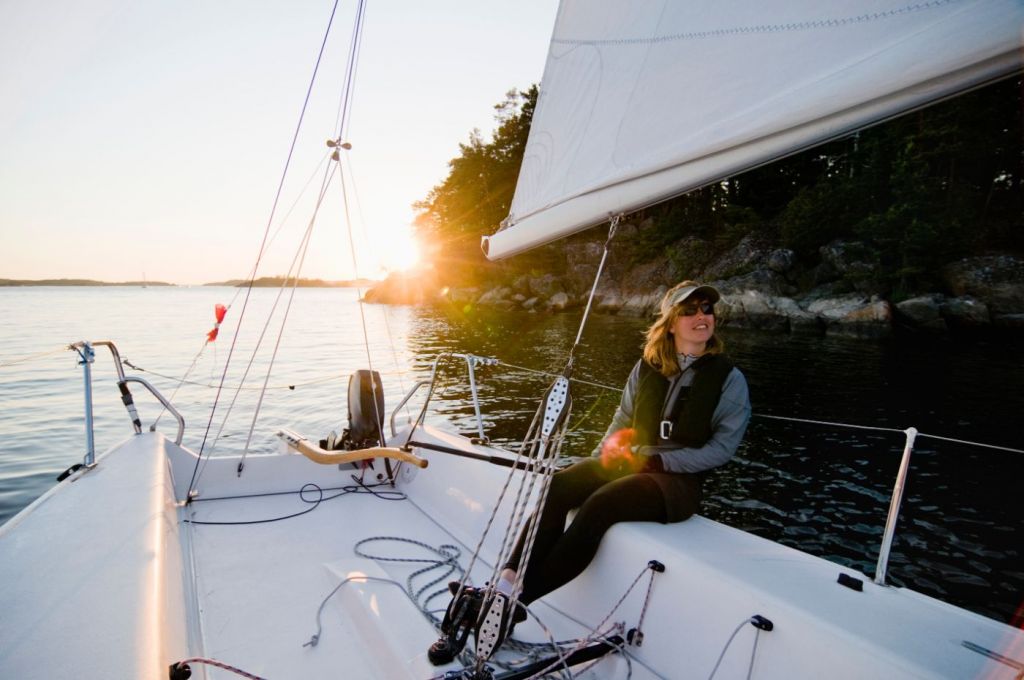
On this page:
What you need for short-handed sailing, features of a good single-handed boat.
Before talking about anything else, let's take a quick look at the features you want in a sailboat for short-handing (a fancy way of saying sailing alone ).
Scroll down to the list of sailboats here .

What to look for in a single-handed sailboat:
- Easy-to-operate sails
- Self-tacking jib
- Self-reefing sails
- Good autopilot
It's nice to have a team of friends, each with their own position within the crew, taking care of their specific thing. One behind the helm, one at the navigation, one trimming the mainsail, one taking care of the foresail, and an extra deckhand just to be sure. But if for whatever reason you want to sail on your own, you'll be the one to fill all those positions.
To make sure that it is physically possible and as easy as can be under the circumstances, start with a good boat choice. The idea is to pick a design that will be easy to operate with just one person available.
Now the good news is that since around 1990, many boat manufacturers have been focusing on ease of operation. That's just what the current market demand dictates. In other words, good single-handed sailboats aren't a rare find.
So what are the specific features to look for when sailing on your own? Let's clear a common misconception first - single-handed doesn't mean the boat has to be small.
Sure, small boats are easier to dock, and things tend to be within reach… but you will find large numbers of 70-footers that are designed as single-handed projects.
You can operate 100-footers on your own. Read all about it in our article What's the largest boat one person can operate?
Easily Operated Sails
A good start are sails that can be operated without much hassle. That doesn't necessarily mean being able to reach all the lines and winches from the helm. If you can, that's great, but if the boat has an autopilot, all you need is to be able to tweak the sails from the front of the cockpit.
Try to avoid setups where you'd have to walk to the mast to play with your sheets - not only it takes time but doing that in heavy winds, tall waves, on a boat that is healing, is a recipe for disaster that nobody is there to save you from.
When solo sailing, the ability to reef and tack quickly is important since those are oftentimes time-sensitive maneuvers. So self-tacking jibs would make your life way easier.
Individually Suitable Boat
The best test, though, is to take the boat out and try it out for yourself. A boat that handles easily in the hands of one person can be unmanageable in the hands of another.
A spinnaker pole might be a handful for the shorter folks, while a 6'2'' 200lbs bloke won't have issues with it.
But don't go around shopping with a 'must-have' checklist. Sometimes the boat is almost there, and all it needs is a little DIY technical push, like adding an extra jammer to the cockpit and running a reef line through it, or getting your hands on a windvane self-steering kit.
As somewhat touched upon before, manufacturers are trying to cater to the ease of use and since technology is going forward, what used to be a hi-tech racing equipment piece years ago, has now made its way into the affordable mainstream.
The canting keel is such an example, something you used to see on racing sailboats only, but now can be put on your average cruiser.
Autopilot Matters
An important part of solo sailing is a good autopilot, for obvious reasons. Luckily, nowadays, these are very reliable compared to what the standard used to be years ago in the cruiser world.
That being said, if you can get your hands on a boat with a proper below-the-deck autopilot with a gyrocompass, you will be much happier than with your average on-deck system, which does the job well, but when things get windier, it might become less reliable.
By the way, racing boats tend to be good solo sailing vessels—they are set up for efficiency. They feature more robust rigging and hulls that can withstand rough conditions and gusts better, and thus are more forgiving, without the necessity to tweak to detail.
I'm not saying that to necessarily have you look for racing boats for your short-handed trips, but rather so that you don't steer away from them on purpose, thinking they would be too much of a handful.
On deck, navigation is a big one too. Again, nothing to cry about if your boat of choice doesn't have one, as it can be easily solved with aftermarket solutions. Or an iPad with the proper app. But having to run below the deck to see where you are isn't the handiest of scenarios, especially in tricky situations.
If possible, consider investing in side thrusters. They can make maneuvering your boat infinitely easier, docking can turn from an unpleasant procedure to a relatively simple joystick play, and especially if you are on a bigger boat, you will appreciate this feature.
We haven't touched on the topic of interiors since it isn't as sensitive as a matter. But having plenty of handles to grab onto regardless of where you are is a good idea, since hitting your head and passing out is unpleasant with a crew, but potentially fatal without it.
To continue with the topic of safety, equipment and boat design aside, remember that you can't really afford mistakes you could make with friends on board. So make sure you have enough spots to clip your harness to, that the boat is sufficiently equipped with communication devices and that all the equipment works as it should.
So let's get specific. What are the nine boats that make great companions for solo sailors?
Let's start with the obvious one—a dinghy. It won't probably be your choice when crossing an ocean, but for practice or a fun day close to the shore, this is one hell of a boat. In comparison to its rivals in the same category, RS Aero is super light weighing 66 lbs. It is among the most technologically advanced sailing dinghies designed specifically for one person.
All of this comes for a price though - 10 000 to over 15 000 USD. You will be getting your money's worth for sure though. An enormous amount of hi-tech work went into this project, and you'd be buying a design that won more awards than could fit on its 13-foot body.
This is a big step up from a dinghy, while still keeping things very simple. It is a lightweight boat, originally designed for a transatlantic race. Thanks to that and its small size, it is easy to handle, the racing pedigree shows in the efficient layout, so everything is within reach. Despite its smaller size, it can reach speeds you would expect of much larger boats.
You can find small family cruisers of the same size, but don't let that fool you. This is very much a Spartan sailboat. Inside, you won't find much more than the bare necessities - two aft cabins, curtains instead of doors, simple seating, not much lining or wood, just a notch above barebones interiors. You get a toilet though, a chart table and a galley as well as much stowage. But you will be reminded of being on a racer, because unless you are shorter than 5'7'', you won't be able to stand up straight.
As mentioned, this boat was designed for a cross-ocean race, so it is a seaworthy bluewater mate that should be able to take you more or less wherever you want to.
Time to go big. As previously mentioned, solo sailing doesn't mean you have to stick to smaller sizes. Why? Because it is a trend now. Even though just some ten years ago, the situation was vastly different, these days, single-handed 60+ footers aren't anything rare.
So why this Beneteau? Well, for one, to meet the new kinds of market demand, it was designed for ease of use, meaning it can be successfully operated by a single person. I don't know what you'd do alone with all that space, but if you want to enjoy oceanic solitude while not giving up the luxuries of having space the size of a family apartment, you can.
And while there are more boats of this size suited for short-handed sailing, like the larger Jeanneaus, Hanses, or even Bavarias, the Oceanis 62 can be yours for around 600 000 EUR new, which is a figure unheard of in that size and quality range up until relatively recently.
This is not the first time I am mentioning this boat in an article, and no wonder, it has so much character! Like others in this list, this one has been designed for single-handed sailing - it had to be. You couldn't fit two people on it comfortably anyway.
So aside from its solo capabilities, why does it deserve to be on the list? Well, it's towable, which you could say about the RS Aero too, but you can actually live on a Flicka, and it is seaworthy. It is about as small as you can go while still being able to cross oceans.
There is no question about everything being within the hand's reach on this one. Ergonomics almost don't matter at this size. Given its towability, the fact that you can park it in your garden, and its short-handed potential makes for the perfect spontaneous getaway mobile.
Another boat you can live on. It is a seaworthy ocean crosser, and thanks to its setup and a self-tacking jib, it is a proper short-handed boat. It also has quite a wide beam, thanks to which you'll get additional stability, further supporting comfort when operating it solo. It is made by a brand that proved its worth over time, as since the 70s, it is still going strong. It's comfortable enough for long distances, with a spacious salon, shower, and space for a small family.
Used, you can get one starting around 150 000 USD, which is one of the reasons why it belongs on this list - if you are serious about solo sailing and want a proper boat without compromises that come with smaller sizes or sportiness, this one is within a reasonable reach. Among the affordable, high-quality, short-handed sailing cruisers, Tartan 3700 has its definite place.
This is the kind of boat I was talking about when I mentioned that formerly racing design aspects started to make it into the cruising world. Hunter started as a racer builder and then shifted to cruisers, while, of course, taking its know-how with them, which makes for boats that are easy to operate, also well-performing ones.
This specific model got on the list because of its low center of gravity, high ballast ratio, and stable hull, which means you won't have to trim the sails all the time to go fast. And less work is always welcome if you are the only person to do all of it.
Another reason it's gotta be here is it is very efficient layout, self-tacking jib, and single-line mainsail reefing system—a smart choice for solo sailors.
If you like what you saw in Hunter Channel 31, but fancy something a bit faster, with a higher quality build, this one's what you want. It has lost much of its sportiness as it is too heavy to be thought of as a proper performance boat today, but in the worst-case scenario, it is a quick cruiser capable of satisfying sprints.
It was designed for single-handed sailing as well as for full crewed racing, so if you want to push as much as you can out of it with a team of your mates, you can, while knowing you will be able to cruise at a good pace when they leave.
So unless you mind the slightly higher price tag, which comes with the high build and components quality, as well as the less generous interior fanciness usually seen in racers, you've found yourself a boat.
The best thing about solo sailing is also the most dangerous thing about it - you will be alone. So you want your boat to be your buddy - forgiving as much as can be, having your back. Amel 60 is such a boat. It has watertight bulkheads, so it is hardly sinkable, its cockpit has a solid roof and windows, so no matter the weather, you'll be protected while behind the helm, it has a stable hull, offering support even in tricky weather, it features electric winches, so you can operate the sails without even touching a line…
...and inside, you get more space and luxury than you could wish for, including a washing machine. All in all, if there is a boat that's got your back even if your skill level isn't the greatest, it is Amel 60. All it wants from you is to be ok with the 1.5 million USD price tag.
Have you seen the film "All Is Lost"? An incredible project without dialogue, where a solo sailor on a Cal 39 makes his way through an ocean. Now, what makes Cal 39 such a great boat for solo sailing? As it turns out, nothing in particular. It wasn't designed with this in mind. It isn't even a notably successful model - though that's mostly due to technical circumstances rather than a lack of quality.
And that's why it must be on this list. To represent all the boats that aren't single-handed projects by design, but make it possible, if you get to know the boat, spend some time with it, and, as mentioned at the very beginning of this article, tweak it so that it makes solo sailing easier.
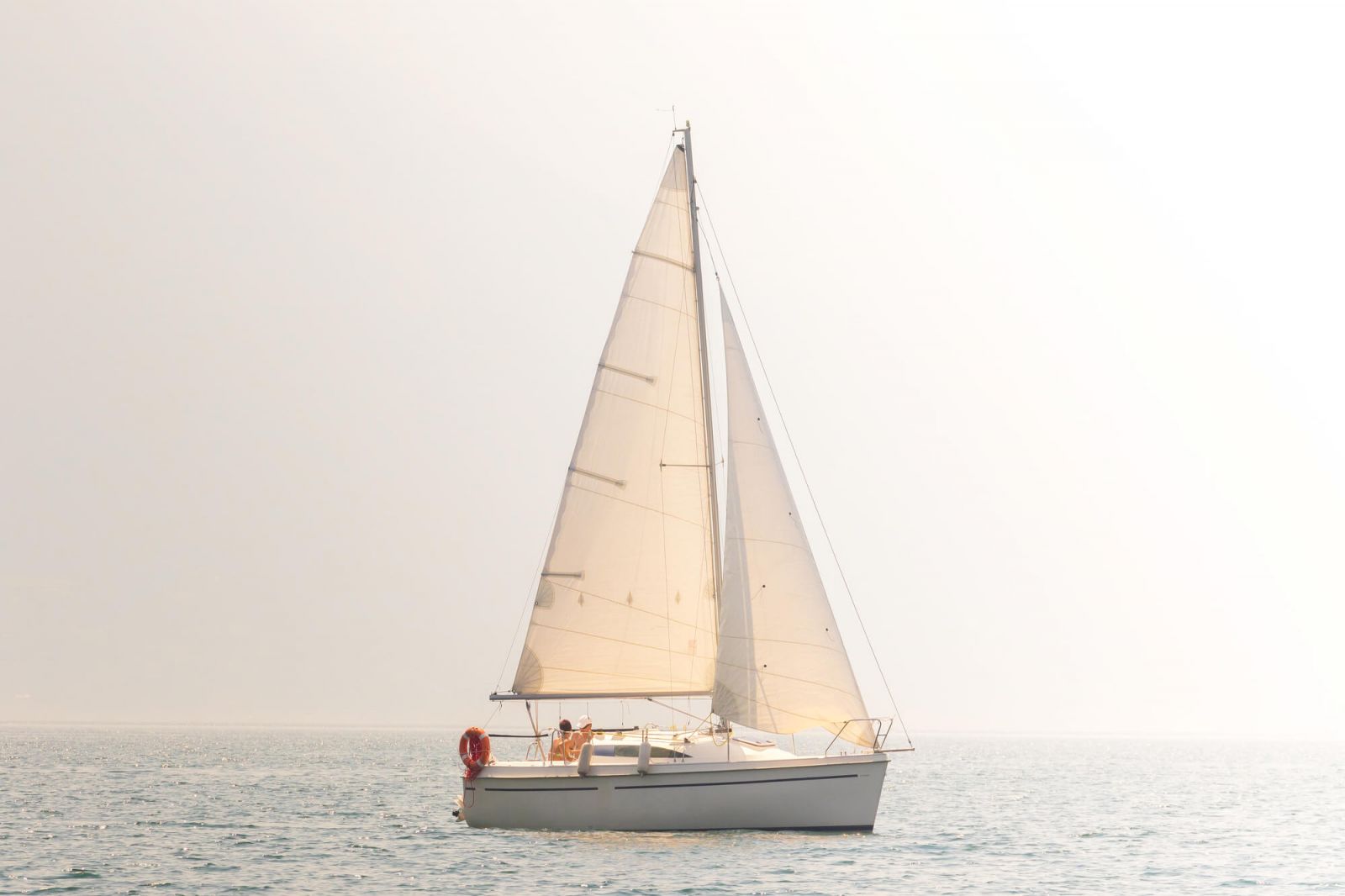
By this, I want to encourage you to get into solo sailing, even if you lack a sailboat that is specifically made for a one-person crew. Quite a few single-handed passages have been done on boats that wouldn't make it to this list because technically, they don't fit the profile. But they were made to be, either with tweaks or with skills. Be honest to yourself regarding your skill level, the boat design, and if it passes the test, go for it.
Happy sailing!
Leave a comment
You may also like, what’s the largest boat one person can operate.
So you're looking for something big, but want to go at it alone. Sailing single-handed (also known as short-handed) is perfectly doable, although not always ideal. …

Raising the Mainsail Single Handed: 5 Pro Tips

How Big Should a Sailboat Be to Sail Around the World?
Own your first boat within a year on any budget.
A sailboat doesn't have to be expensive if you know what you're doing. If you want to learn how to make your sailing dream reality within a year, leave your email and I'll send you free updates . I don't like spam - I will only send helpful content.
Ready to Own Your First Boat?
Just tell us the best email address to send your tips to:

11 Best Single Handed Bluewater Sailboats

Sharing is caring!
We know that you’re serious about sailing when you finally think of venturing to the ocean. Who can resist dreaming of solo sailing through the Atlantic? This is an adventure to prove your advanced skills, strength, and experience.
But before going off on your ocean adventure, you need to plan and prepare . We cannot stress enough the importance of good equipment. There is a lot of sailboat types and models in the market and we want to help you choose the best one for your needs.
Do you know what hull, rigging, and keel types you will need? What’s the best material and model for you to buy?
We will guide you through important sailboat features needed for the cruise. Follow this review until the end and we will share the 11 best single-handed blue water sailboats for your solo ocean sailing!
What Size Sailboat Is Best for Single-Handed Sailing
What type of hull handles rough water the best, sailboat keel types for blue water sailing, keel or decked stepped mast, sloop or ketch, how many spreaders, cutter rig, self steering gear, furling sails, westsail 32, albin vega 27, pacific seacraft 34, canadian sailcraft 36 traditional, hallberg rassy 352, contessa 32, fast passage 39.
If you are planning to manage your boat single-handedly, then size is an important factor to consider. It can affect the size of your accommodation, and maybe the boat’s design for speed and power.
Being alone, you need to have a clear overview of what is happening on your boat. This is especially important when maneuvering or for docking operations.
Experienced sailors can handle a 60-foot sailboat but novices would find it difficult with its steep learning curve . Check out the Vendee Globe if you don’t believe me. In general, a good sailboat size for single-handed sailing would range from 25 to 40 feet.
We recommend sailboats with sizes under 40 feet. These have good displacement and are great when against bad weather. They are solo-friendly and simply the most manageable.
But in the end, choosing a suitable size depends on your experience and preference. You need to consider your overall health, age, and physique. Make sure to have a complete understanding of your sailboat before going on your journey to prevent accidents.
The hull or the main body of your boat comes in varying shapes and sizes. Each different type of hull is designed for specific purposes.
When venturing the blue waters, you need to have a hull design that could handle rough waters easily. The hull shape determines the performance of your sailboat and therefore, should align with your strengths and skills.
Today, the most popular design would be the heavy displacement hull . This design is intended for ocean cruising and longer sailing travels.
It has great stability and performs better the deeper the draft is. With this design, you would expect a slow and steady motion during your sea travels with minimal effort.
V-type hulls, on the other hand, are designed to plane or ride on top of the water. You can usually see these types of hulls on powerboats. The V-type hull usually has a bigger engine and best when dealing with choppy waters while moving at high speed.
Narrow beams are also a great option for those who are looking for another ocean friendly feature . These are usually seen in traditional sailboats.
Canoe stern or the double are considered to be the best sterns for offshore sailing. They help cut through a following sea and really helps prevent the waves from pushing the stern over too much. It also has great buoyancy and balance that is perfect for bluewater cruising.
The best materials for hulls would be fiberglass, metal, and aluminum. These are durable and could last for decades if properly maintained.
Aluminum is lightweight and has resistance to corrosion and impervious to magnetism. Boats built with aluminum are fast, stable, and seaworthy.
Fiberglass hulls need less attention. Currently, boats are usually made of fiberglass as the material is easier for companies and also great for seakeeping and stability.
Metal like steel has high abrasion resistance. It helps retain the boat’s appearance but can be prone to rust and corrosion.

A keel is a fin-like blade found at the bottom of a sailboat. It supports the ballast and helps to control and steer the boat.
It is generally designed to stop the boat from getting blown sideways because of wind pressure. The full keel, modified full keel, fin skeg, and fin spade rudder are all suited for bluewater sailing.
A full keel runs along the full length of the boat – from the bow to the stern – which makes it the most stable in the water. It carries the vessel well and is the safest to use when grounding as it reduces the chances of damage.
This is most ideal when cruising and the most comfortable out of the four keel types with its minimal heel. Although the slowest on the list, it has great directional stability and steering capability.
An improved version is the modified full keel . It is a hybrid with improved windward performance and better heel reduction than the full keel. However, it made small concessions on its stability and comfort.
Meanwhile, the fin keel with skeg rudder has more strength and protection against damage and impact. It also has better mobility and steering capability.
This type has a faster speed and windward performance compared to the modified and full keel types. It is also more balanced, which is ideal for cruiser-racer types of sailboats.
Lastly, we have the fin with a spade rudder. This is the fastest type on the list but also the most vulnerable as the spade rudder greatly relies on the rudder stock. But if you want speed and great windward performance, then this type is the right one for you.
Sailboat Rigging Types
Rigging is the whole system of ropes, chains, and cables. It supports the sailboat mast and controls the sails’ orientation and degree of reefing.
There are two main groups of sailboat rigs, Deck Stepped and Keel Stepped. The main difference lies in the location of its mast step. Both are fine choices and the better rig would depend on your preference.
Just as its names suggests, you can find the mast stand on top of the deck with Deck Stepped and on the hull’s bottom with Keel stepped. This means that to reach the keel, the mast would need to pierce through the cabin.
Deck Stepped rigs have masts that are more flexible because of their contact points, and are easily adjustable for optimal performance. Keel Stepped rig is rigid and strong and offers slow and steady cruising.
Now let’s move on and talk about Slope rigged and Ketch rigged. Which is better?
A sloop rig is simple. It is composed of a mast with a jib and a mainsail. Ketch, on the other hand, is more complex with its two masts with any foresail, main and mizzen mast combinations.
If you are choosing between Sloop and Ketch rigged sailboats for solo sailing, then we recommend Sloop. Although, Ketch is manageable and can be easily used with less strength and effort. This is perfect for cruising as it can work around multiple sailing conditions.

In terms of spreaders, you can freely choose between a single or dual spreader. This deflects shrouds and supports the mast. We do recommend dual spreaders but single spreaders are also good.
It’s just that double spreaders give the rig more strength and better sail control.
The cutter rig is sometime referred to as an inner forestay or baby stay. Simplest way of describing it is that you have two head sails instead of just one. Gives you more options on sail configurations.
Single Person Sailboat Equipment and Gear
Your sailboat would not be complete without gear and equipment. You might want to invest in autopilot or wind vane, furling headsails, electric windlass, life jackets, and AIS to make your voyage much easier.
Wind Vane is an autopilot steering that you can use without electricity. It is usually placed on the back to catch the wind and respond to various wind conditions.
It automatically adjusts the rudders in response to the wind to alter the boat’s course. This is helpful because it’s like having another crew member on board you don’t have to listen to and feed.
Headsail furling or roller reefing is necessary for easier management of your headsails. It is important to have a functioning and updated roller furling system in order to reef, dowse, or stow the headsail efficiently.
Another item we would recommend is an electric windlass . You can choose one that works vertically or horizontally, depending on your needs. This will help you move the anchor effortlessly with a single button. Using the two windlasses that god gave you makes anchoring more difficult then it needs to be.
Life jackets are a must in every sailboat. Just be sure it fits you and that you know how to use it. Also, be sure to buy a coast guard approved product with a harness that could support your weight.
The Automatic Identification System (AIS) will help you avoid collisions . It is recommended to get a receiving and transmitting one when going solo sailing.
This way, you and the other boats with AIS within the radar area are alerted to each other’s speed, course, and direction.
Really, you won’t know what you might encounter in the ocean so you must always be prepared. We hope that these items will help you achieve a safer and more secure sailing experience.
11 Best Sailboats for Solo Sailing
Now, here are 11 sailboats that are best for solo sailing. Any of these vessels are guaranteed to take you safely and comfortably anywhere around the world.

This is a long full keel fiberglass sailboat that was built from 1971 to 1981. Its design was based on a previous model, Kendall 32, and has an amazing interior size geared for comfortable cruising.
W32 is widely noted for its seaworthiness. It is built with a strong and durable design and materials to resist extreme sea conditions.
It was used on various voyages and circumnavigations. Its hull is a heavy displacement and double-ender type designed for long periods of sailing.
It is also a cutter-rigged sailboat equipped with a single mast, forestaysail, mainsail, and jib. Its overall length including the bowsprit and boomkin is roughly 40 feet, which is perfect for sailing single-handedly.
Most people would note that the speed and acceleration of W32 are quite slow. This is due to its larger wetted area and sometimes newbies’ mistake of carrying too much on board.
With the right keel, sails, and rig configurations you can improve on W32’s speed and weaknesses. As seen from David King’s documented modifications, W32 proved to be safe, steady, and fast when sailing on blue waters.

Vega 27 is a modified full keel sailboat with a masthead sloop rig. It was designed around 1966 and became the most popular production sailboat in Scandinavia.
It has a unique look because of its reverse sheer commonly seen in smaller boats to increase the area of its interior. It is made with fiberglass, but has a narrower hull compared to similar sized boats in its class.
Its shallow hull has a large cutaway as seen with modified full keel designs. This can make her quite stiff, heeling to about 15 degrees when its shoulders are buried.
Still, it is great for single-handed sailing because of its manageability and balance under different conditions. You cannot help but admire its light helm and great tracking capability.
Vega’s light air performance is okay but it shines when the wind blows at 15 knots or more. It could even maintain its dryness even with rough waves and weather conditions.
The most comforting feature would be its control and stability at all times unlike other more modern vessels with spade rudders. Overall, it is safe and ideal for longer cruises offshore.

This 30-foot traditional sailboat could take you anywhere. Alberg is notable for its narrow beams, long overhangs, and full cutaway keel with its directly attached rudder.
It is strong and durable. Its materials were mostly aluminum, hand-laid fiberglass, and polyester resin. More ballasts were produced in later productions as the early ballast was built with iron as opposed to the original lead design.
Alberg is greatly influenced by folk boats in Scandinavia. It is built with fiberglass and has an interior with comfortable full standing headroom and a well-vented galley.
This classic design from 1962 is ideal to cross oceans and is used for various circumnavigations. Alberg is a stable and seaworthy boat that could even be used in casual racing. Its best point of sail seems to be a beam reach and close reach.
It is praiseworthy when crossing oceans. Unlike modern designs that tend to be thrown around on rough seas, Alberg’s narrow beam design slices through big and rough waves and moves quickly. Under extreme weather conditions, it could perform heaving-to and lying-a-hull with no problems.
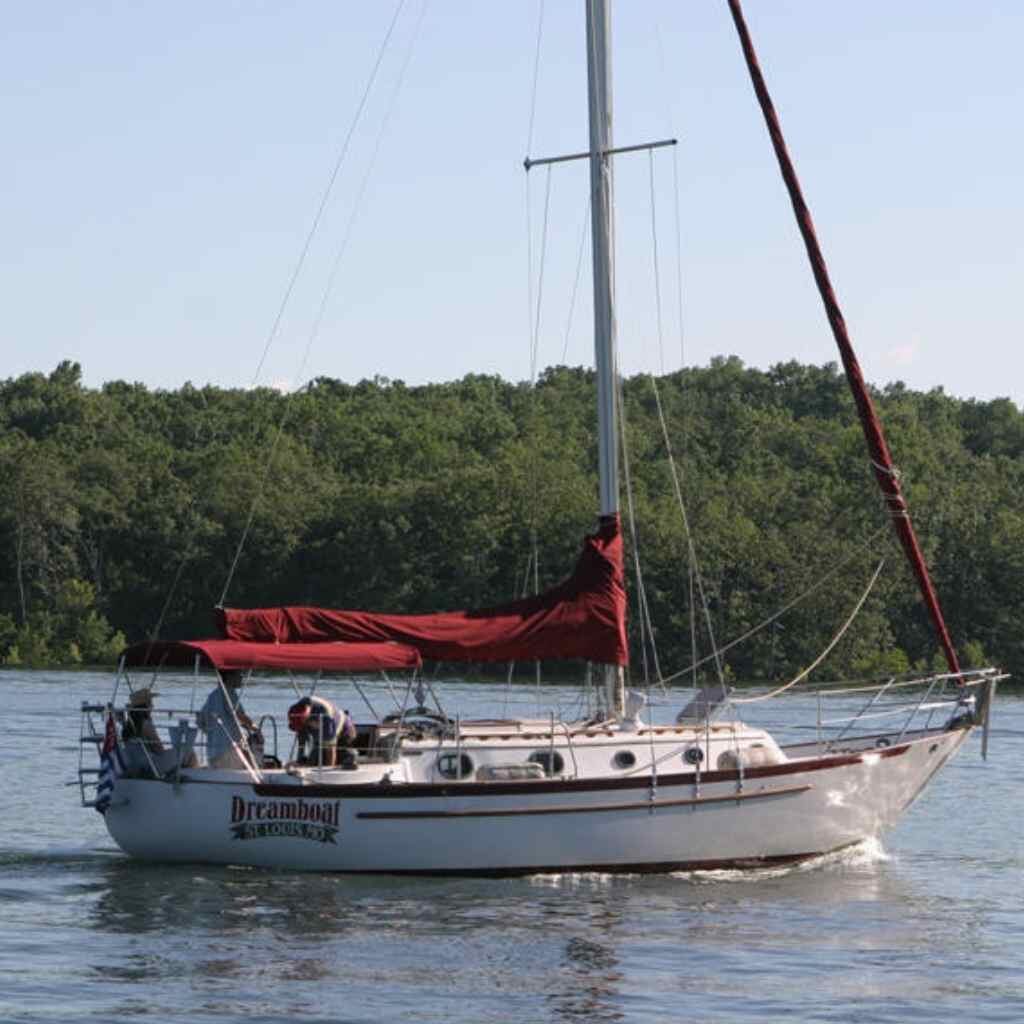
Pacific Seacraft 34 is a smaller heavy displacement semi-long keel sailboat based on the highly successful Crealock 37. It has the same graceful lines and appearance as the Crealock and is known as the Voyagemaker.
It is built with comfort and safety in mind with its large overhanging bow and beautiful sheer line ending with a traditional canoe stern. Constructed with the highest standard, it is a seaworthy sailboat that is ideal for bluewater voyages.
It is a cutter-rigged sailboat with skeg-hung rudders and control lines being fed back to its cockpit. The smaller cockpit may feel cramped but its design lowers the risk of flooding.
Still, it has a great interior suited for living aboard. It has a large headroom, comfortable galley, and up to five berths for comfortable cruising.
Although you may feel some hobby-horsing windward because of the overhangs, Seacraft 34 is overall a very balanced boat with great upwind performance. It has outstanding control capabilities and is able to sustain surfing speed with ease.

This is a double-ended full keel cruiser designed by Bob Perry and built-in Taiwan in response to the rising popularity of Westsail 32. It was offered to the market as a semi-custom boat and built with high-quality materials.
You can modify the internal layout and can choose a ketch, cutter, or pilothouse version. There is an option to use wood or aluminum spars. The mast could also be keel-stepped or deck-stepped.
Before, only 20 were ketch sailboats due to the popularity of the cutter design at that time. Now, ketch has proven to be faster and more balanced between the two.
Tayana is relatively faster than any sailboat in its class. Its best point of sail is in its broad reach. It also tracks well windward, and is an ideal choice for the trades. It is also great how the cockpit is secured from any flooding even when traveling.
Today, a lot of people are still actively sailing this. Tayana 37 has become well known for offshore and blue water sailing.

Canadian Seacraft is well known for its fiberglass racer and cruiser. CS 36 is a small traditional fin keel sailboat with a masthead sloop intended for recreational use. It is seaworthy and has good performance in different weather conditions.
It was designed by Raymond Wall and had a production run between 1978 to 1987. It remains to be popular in both north and south borders.
It is a beautiful sailboat with a graceful sheer line and balanced overhangs at both bow and stern. Its details and quality in design and production are clearly of a higher tier.
It is mostly built with fiberglass and balsa wood. It is equipped with an internally mounted spade transom hung rudder. All of its lines lead to the cockpit, which is ideal for single-handed sailing.
CS 36 Traditional also has a deep-depth draft and wide beams with great access to the cockpit and foredecks. It is wide and spacious, which is perfect for comfortable cruising.
The sailboat has great proportion and traditional aesthetics. It is simple and straightforward, which makes it ideal for bluewater sailing.

This is a sturdy and high-quality sailboat built between 1978 to 1991. It features a progressive design, combining a walk through with the aft-cabin from the main saloon. It is made with a tall and standard rig each supported on double and single spreaders, respectively.
Hallberg Rassy 352 has a nicely balanced hull sporting a fin keel with rudder on skeg, a generous beam, and a 45 percent high ballast ratio. Its water and fuel tanks are placed low in the keel to improve sail carrying ability.
Its production spanning 14 years allowed for continuous improvements in its specifications. Newer sailboats have raised hulls for bigger headroom in the under the deck, aft cabins, and the walkthrough. Engines were also replaced by a Volvo and later a Penta Turbo or the bigger MD 22.
It is impressive how they balanced good interior and sailing performance. It has great seakeeping ability and smooth motion in heavy seas, easily an ideal sailboat for singlehanded sailing.

Corbin 39 was designed based on a Dufour design named Harmonie, increasing freeboard, and flushing the deck. Its style is influenced by the classic Scandinavian cruiser, Westsail 32.
It has a long fin keel, blunt bow, and a high freeboard. It was sold as kits, and various deck molds were produced. They have pilot, aft, and center cockpit variations.
It was made of sturdy and high-quality materials. The earlier version’s decks were of marine grade mahogany but it was later changed with Airex foam. Its lead ballast was encapsulated with fiberglass for added protection.
Earlier boats had a single spreader main or a turbocharged double spreader. Later, Corbin used 49 feet double spreader rigs instead, and all were deck-stepped.
Corbin 39 is truly a strong and seaworthy vessel. With its fin keel and skeg rudder, cutter rig, and reefed main combinations, it could take anyone safely and comfortably anywhere in the world.

Valiant 40 took its looks from Scandinavian double-ender sailboats. It had a successful production run that spanned for 47 years. It proved to be one of the pioneers for modern blue water designs.
Its hull is made from thick hand-laid fiberglass, bolted and covered with teak. Its ballast is cast with lead bolted to the keel stub. Lastly, the skeg is constructed separately from hull molding and encased with fiberglass before being fastened to the hull.
It has a beautiful bow and sheer lines and a longer LWL for maximum speed. At the back are a non-spacious cockpit and a canoe stern ideal for bluewater sailing operations.
Under the waterline is a fin keel with its skeg hung rudder. It perfectly matches with the cruising hall above, minimizing wetted surface area
Overall, Valiant 40 is a seaworthy vessel with great blue water performance. Extremely balanced and well-mannered, it can withstand extreme weather conditions with ease and minimal effort on your part.
It soon gained a reputation as a fast water passage-maker with high integrity. Now, it is regularly used for circumnavigations by solo sailors and voyagers.

If you like a sailboat with a proven track record, then Contessa 32 is for you. It is a seaworthy racer-cruiser with good all-around sailing capabilities released in 1971.
Like its younger sister, Contessa 26, it has great speed, integrity, and affordability . Contessa 32 is a definite combination of old and new with its traditional narrow beam, a full hull with a fin keel, and fiberglass rudder protected by a skeg found in more modern yachts.
It has marked overhangs and a narrow tuck-up stern. It has less headroom below in return for its lesser wind resistance.
This configuration delivers fast racing speed and great stability. It could definitely withstand extreme weather and rough waves. Contessa 32 is claimed to be able to right itself when rolled or capsized.
Contessa 32 is known for its forgiving nature. It has a responsive helm and excellent windward performance. With its astounding stability, it can carry full sail for up to 25 knots.

Fast Passage 39 was designed by William Garden and is said to be a legendary cruiser with speed, ruggedness, and fame. It is a stout double-ender comparable to the Valiant 40.
It has the same LOA and LWL as Valiant and also has nearly identical ballast and displacement. The difference is its narrower frame and more evolved underwater shapes resulting in flatter forward and aft keel sections and less wetted area. It also has great directional stability as its rudder allows great control under wind vane and down steep waves.
It is a high performing sailboat but also difficult to find as only 41 were produced. A part of the group was offered as hull and deck kits intended to be finished by the sailboat owners.
Fast Passage 39 also has a proven track record and has won single-handed blue water races. It performs great under a wide range of conditions, especially in light winds.
By now you should have some idea what makes a vessel Bluewater friendly. There are hundreds of vessels that can make long distance voyage safe and enjoyable. These examples above are just a few examples of the Best Single Handed BlueWater Sailboats.
Leave a Comment Cancel Reply
Your email address will not be published. Required fields are marked *
Save my name, email, and website in this browser for the next time I comment.
Get your "Sailing and Boating" Free Guide
Better Sailing

Best Sailboats to Singlehand
Sailing alone can be an extraordinary experience for many boaters. Many have attempted to sail on long passages and explore the oceans. But, a common concern is, which one is the right boat to sail single-handed? We’ll find out together in this article. Fortunately, there are many suitable seaworthy vessels for one person. In this article, I list you the best boats to single-hand as well as find out what makes them appropriate for single-handing. These boats range from small lake dinghies all the way to comfortable cruisers capable of oceanic crossings. So, keep reading!
A Few Things About Single-Handed Sailing
There are many boats that perform particularly well for shorthanded sailing. However, the fact is that the structures on a boat have a greater effect on its suitability rather than the boat’s construction. Main features regarding single-handed sailing include easy sail controls, including the ability for one person to quickly tuck a reef in. And, let’s not forget the ability to easily change the sheets and the mainsheet traveller. If you’re looking for a boat to short-handed sail, start by looking at the reefing and sail handling systems, as well as the pilot’s specifications. It’s a great advantage to be able to reach both mainsheet and the primary winches from the helm. But, when sailing on long passages then the pilot might be steering for almost 100% of the time.
For shorthanded sailing, many sailors prefer smaller vessels. This point has a lot of sense because their compact size, ease in navigation in a small room, and less complicated structures, make them more simple to sail. But, keep in mind that there are also sailboats of 70ft that are set up to be handled by 1 or 2 persons on deck. In which case, the sailors must be experienced and be able to fix any damaged system. So, if a vessel is properly set up it can be easily handled by one or two experienced sailors, no matter its size.
Boats made from the early 1990s onwards are more stable than their ancestors, as well as deep draught low center of gravity keels. These are a great choice for single-handing. The added stability means a reduced need to reef which facilitates the overall sailing experience and performance.
In any case, the below-mentioned boats, and similar others in each respective range, form great choices for single-handed sailing. They all offer easy short-handling for either beginners or experienced. And also for those that want to experience calm sailing to those seeking a fast and responsive, but ultimately safe, vessel.
Handling and Set-up
First of all, when solo sailing, it’s important to focus on the ease of handling your boat. This is because you will be in charge of all roles; skipper, navigator, bow-person, dial trimmer, engineer, and chef! So, what you want to achieve here is making all these roles simpler in order to facilitate all tasks.
So, it’s advisable to take your boat out on a calm sea and experience all possible motions of sailing. Like you were racing or cruising but also hoisting sails, trimming, steering, and navigating. Like this, you will be able to see if any problems come up. The most common problem sailors experience is reefing the mainsail by themselves. Also, the spinnaker pole might be too much to handle by yourself or find it difficult to reach the sheeting positions. In other words, if you’ve never sailed short-handed before, this first experience might seem challenging. And, some things are really important to handle like reaching the main traveler while steering. But, don’t get discouraged! Consider taking notes while onboard, and start finding new ways of facilitating your voyage.
Some simple changes include shifting a halyard clutch. But, there are more challenging ones like switching to a single-line reefing system. Wherever feasible, a single-line reef system is preferable. But, adding a reef tack line and getting back to the cockpit can be even more convenient and require less line that will probably tangle in the cockpit. Keep in mind that the most important factor for single-handed sailing is to make your boat easier to sail. So, now let’s see the best boats for single-handed sailing!
The Hanse 371 was built from 1999 until the mid-2000s. The boat offered a selection of either deep or shallow low center of gravity fin keels. These were joined with the hull and a long waterline. Below the deck, you can choose between 2 or 3 cabin layouts with a comfortable galley. Hanse 371 benefits from self-tacking jibs so when tacking all you have to do is spin the wheel. And, in case you’re sailing on autopilot you just press a few buttons and you’re good to go.
In addition, you can increase sail area when reaching in light air with a Code 0 or asymmetric spinnaker. This model maximizes the amount of space and with a reasonable budget. So, with its great interior and performance, the Hanse 371 is a seaworthy vessel that may cost you around $60,000. Most importantly keep in mind that everything is standard and easy to use. Like this, you simplify your life while sailing single-handed.
Jeanneau Sun Fast 3200
The Jeanneau Sunfast 3200 was manufactured with offshore short-handed sailing taken into account since the beginning. This boat is not only a classical sailing boat but also a small and light one that is easy to navigate. Even better, it has the durability and strength to withstand long passages. And, for this reason, they built it specifically for the Trans-Atlantic race. This boat is especially impressive when you sail off the wind, and totally practical and reliable even when sailing alone. This could be due to the fact that the design and setup are mostly constructed for racing. So, it could be ideal for you if you’re looking for a coastal cruiser that’s easy to handle.
Even when sailing downwind, you can easily achieve double figures in terms of speed with this boat. In particular, the Sunfast 3200 features cutting-edge technology to provide you with the best strength-to-weight ratios possible. It has all of the requisite features to easily adapt it to perform admirably as a sailing or racing sailboat. The boat features two double cabins, a chart table, a galley, and a head compartment.

>>Also Read: Best Sailboats Under 20ft
Beneteau Oceanis 62
Let’s now pass to the bigger fellas! As aforementioned, single-handed sailing doesn’t mean you have to choose small sailboats. This is because nowadays single-handed 60+ ft boats aren’t that rare in terms of production, as they were in the past.
Basically, the Beneteau Oceanis 62 meets the modern demands of today’s market and was specifically designed to provide ease of use. In other words, it can be easily handled and operated by a single person. I know that all this space might be a bit exaggerated, but if you’re the kind of person that enjoys being in oceanic solitude while benefiting from having a moving apartment, then this one is for you! Of course, there are more boats of the same size suited for short-handed sailing, like the Hanses, Bavarias, and Jeanneaus. But, you can find a new Oceanis 62 for around $724,500, which is a great price for boats of that size combining both performance and quality.
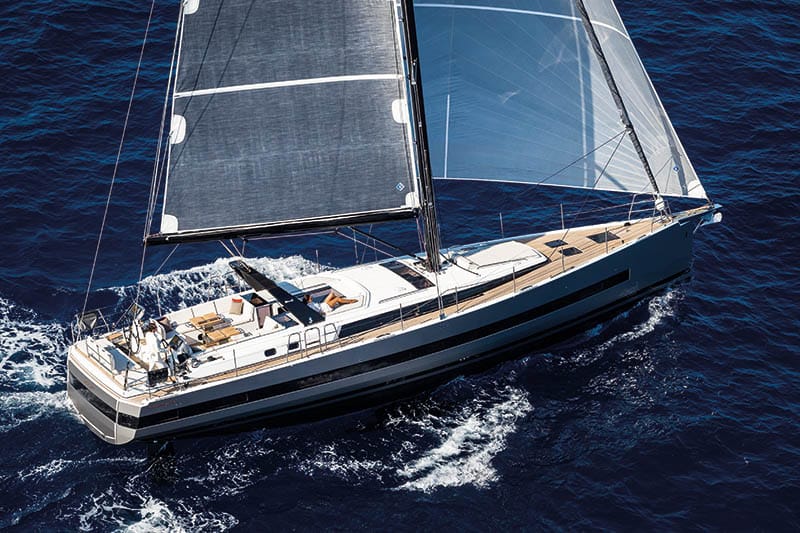
>>Also Read: Is It Dangerous to Sail Around the World?
Hunter Channel 31
From the mid-1980s onwards, this British boatbuilder transitioned from racing to powerful but easy-to-handle small cruisers. As a result, a series of boats has been developed that can sail almost effortlessly without losing handling characteristics.
The deck layout features an effective layout, with an optional self-tacking jib and single-line mainsail. As a short-handed sailor, you’ll benefit from the tiller steering, which allows you to steer with your legs while trimming sails. The accommodation below decks is well-designed and provides considerably more room than the previous Horizon 30 model.
This model, which debuted in 2001, was of higher quality than the majority of Hunter’s other cruising models and greatly focuses on performance. It was also one of the company’s last all-new designs, so it benefited from the most up-to-date design at the time. This was especially apparent in the well-balanced hull shape, which also provided excellent form stability. Joined with high ballast ratios and low center of gravity keels resulted in a boat that doesn’t need continuous trimming to maintain high average speeds or avoid repeated broaching in gusts.
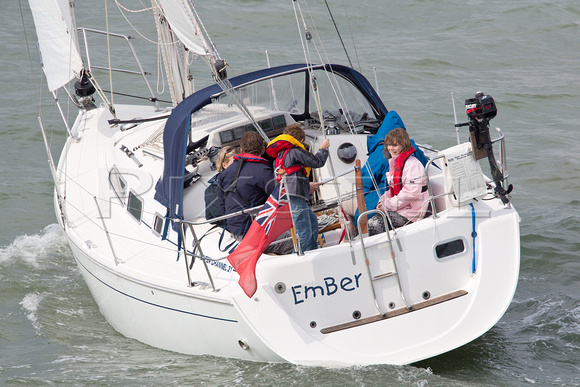
>>Also Read: How Far Can you Sail in One Day?
This is the prototypical short-handed performance boat in several respects. Long-distance single-handed and double-handed sailors love it as well as inshore racing teams. The boat’s offshore reputation has been well established, with many North Atlantic crossings under its belt. Although J/109 is often considered as a planing boat, this 19-year old model is too heavy to be one of that kind. It is basically a moderate all-rounder that offers great performance with the ability for extended surfing when offshore. The boat is also available in a shoal draught form, but it didn’t sell that much.
A great advantage is that the big asymmetric spinnakers can be easily gybed from the cockpit in light airs. And, a poled-out jib can still provide fast downwind speeds with an enviable degree of control in a true wind of more than 20 knots. Almost everyone sailing J/109s short-handed, at least in Europe, hasn’t used the boat’s original overlapping genoas so as to employ blade jibs that are set on roller furling gear.
The only downside is that the boat is expensive for one of this size on the second-hand market. However, its quality of construction and the high standard equipment aren’t going to let you down. Moreover, the interior layout is sparse and has less interior space, although it provides a well-designed and effective two-cabin compartment.
Catalina 315
This is a stylish pocket cruiser that raises the bar for solo sailors by providing exceptional comfort and efficiency. With a hull length of 31′, the Catalina 315 has more interior space than most classics and is still ideal for solo sailing. Rigging the Catalina 315 is a lot simpler with a masthead sloop because it has both an in-mast roller furling mainsail and a roller furling genoa.
Despite the fact that it is a much larger boat, it has a few key features that make all the difference. The split backstays, for example, are excellent for balance and functionality. This is one of the key reasons it was named the 2013 Boat of the Year Best Inshore Cruiser by Cruising World. The boat might surpass your needs when sailing solo, as it is a high-end sailboat with a price tag of more than $175,000. However, if that seems too pricey, you can look for a used model, which will be slightly less expensive.

Pacific Seacraft Flicka 20
The Flicka is a 20-foot sailboat developed and planned for extended cruising and bluewater sailing. The Newport workboats of the 19th century were distinguished by their sweeping sheer, proud bowsprit, blunt bow, broad beam, and low side decks. Flickas by Nor’Star and Pacific Seacraft have withstood the test of time. This is because most Flickas were made with polyester resin or vinlyester resins later on in the production.
For some sailors, this is a disadvantage as you don’t realize just how small the Flicka is until you step into the cockpit. However, it’s a seaworthy vessel and offers a remarkably spacious interior. In addition, the robust tiller is mounted on the transom, thus giving good leverage for steering and freeing up cockpit space. As for the interior, there really is enough standing headroom as well as the open-plan without a full forward bulkhead opens things up. The galley offers all basic equipment and the V-berth is large and comfortable.
On top of that, the Flicka is towable, seaworthy, and you can actually liveaboard. Even though it is a small craft you can still cross the oceans with it. On this one, there’s no denying that everything is within easy reach. At this scale, ergonomics are almost irrelevant. Because of its towability, the fact that it can be parked in your garden, and its short-handed capability, it’s the ideal spontaneous getaway vessel.
Amel 60 definitely got your back while sailing solo in the oceans. The Amel 60 features great advantages and, with its rectangular hull portlights and wraparound windscreen, it takes you on the modern cruising generation.
Fixed bowsprits and plumb bows ensure a modern design and experience. In addition, lines open out into beamy sections aft and benefit from twin rudders. And, since these forms, when paired with the proper buoyancy distribution, can provide a faster hull form, it’s a no-brainer for cruising designs to follow the secondary benefits that come with this fuller form. The watertight bulkheads ensure that the boat won’t sink. Moreover, the cockpit has a sturdy roof and windows, so you’ll be safe no matter the weather. And, the stable hull ensures great handling even in challenging weather conditions.
One of the main benefits is the increased volume, which applies to both the accommodation and the deck lockers. When heeled, twin rudders minimize drag and provide a more balanced feel while underway. However, if they get damaged they provide a redundancy level. The shallower rudders also help in mooring stern-to for those who spend more time in areas like the Mediterranean. In the interior, you get enough space and luxury as well. There’s even a washing machine! So, even if you are an experienced single-handed sailor that wants to benefit from space and performance, then with the $1.5 million price you will get this luxurious boat!
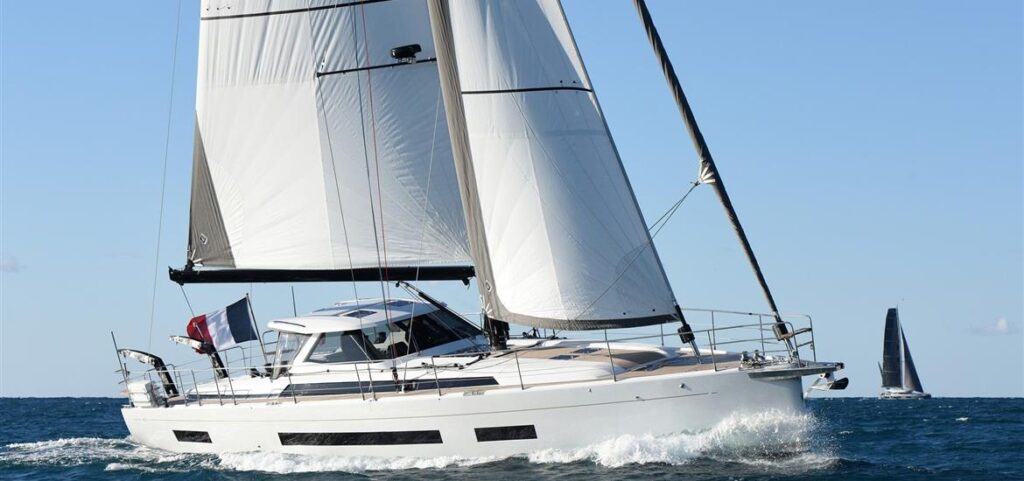
Beneteau 31
As a small cruiser keelboat, this French-designed vessel is predominantly constructed of fiberglass and is ideal for single-handed sailing without minimizing interior space and comfort. Its galley has ample storage and counter space, as well as a sit-down navigation station with a small table. The interior benefits from the straight-lined and elegant thinking of Nauta Design. The comfy seats on either side of a drop-leaf table double the living space. There’s also a spacious athwartship aft-cabin berth and V-berth.
Under power, maneuvering this boat is a breeze, and it’s well worth it for any solo sailor looking for a coastal cruiser. It has a fractional sloop rig, which allows for in-mast furling. This makes it simple to control while also making it strong in light winds. A bow pulpit and an optional asymmetric cruising chute will enhance the performance if you’re sailing the boat off the wind. The new 31 is estimated to cost about $115,000, which is very pricey but well worth it if you want to cruise the globe in this French masterpiece.
Best Sailboats for Solo Sailing – The Bottom Line
Singlehanded sailing is a great achievement in terms of adventure and endurance, especially for lone sailors that cross the oceans. Many experience sleep deprivation, the stress of being alone, and difficult weather conditions that have to be handled by yourself. So, if you decide to set sail for an offshore voyage on your own is a big step to make. And, surely you need a sturdy and seaworthy boat. All the aforementioned boats are considered to be the best cruisers for single-handed sailing. It is up to you to decide which one to choose. This will be determined according to your budget, preferences, needs, and course of your voyage. And, remember that sailing solo learns you to live independently which is a great achievement!
Peter is the editor of Better Sailing. He has sailed for countless hours and has maintained his own boats and sailboats for years. After years of trial and error, he decided to start this website to share the knowledge.
Related Posts

The Ultimate Guide to Choosing the Best Fishing Line for Trolling

Lagoon Catamaran Review: Are Lagoon Catamarans Good?

Best Inboard Boat Engine Brands

Are O’Day Sailboats Good? A Closer Look at a Classic Brand
- Buyer's Guide
- Destinations
- Maintenance
- Sailing Info
Hit enter to search or ESC to close.
- BOAT OF THE YEAR
- Newsletters
- Sailboat Reviews
- Boating Safety
- Sailing Totem
- Charter Resources
- Destinations
- Galley Recipes
- Living Aboard
- Sails and Rigging
- Maintenance
- Best Marine Electronics & Technology

20 Best Small Sailboats for the Weekender
- By Mark Pillsbury
- Updated: August 4, 2021
In order to go cruising, most of us require a sailboat with a head, a galley, and bunks. The boat, likely a 30-footer and more often a 40-footer, will have electronics for navigation and entertainment, refrigeration if the trip is longer than a coastal hop, an engine for light wind, and, depending on our appetites for food and fun, perhaps a genset to power our toys and appliances.
To go sailing , however, all we really need is a hull, mast, rudder, and sail. To experience the pure joy of sheeting in and scooting off across a lake, bay, or even the open ocean, there’s nothing better than a small sailboat – we’re talking sailboats under 25 feet. You can literally reach out and touch the water as it flows past. You instantly feel every puff of breeze and sense every change in trim.
Some of the boats in this list are new designs, others are time-tested models from small sailboat manufacturers, but every one is easy to rig, simple to sail, and looks like a whole lot of fun either for a solo outing on a breezy afternoon or to keep family and friends entertained throughout your entire sailing season. This list is made up of all types of sailboats , and if you’re looking for a list of some of the best small sailboats for beginners, you’ll find exactly that here.
Any one of these popular boats could be labeled as a trailerable sailboat, daysailer, or even a weekender sailboat. And while most would be labeled as a one or two person sailboat, some could comfortably fit three or even four people.
Marblehead 22 Daysailer
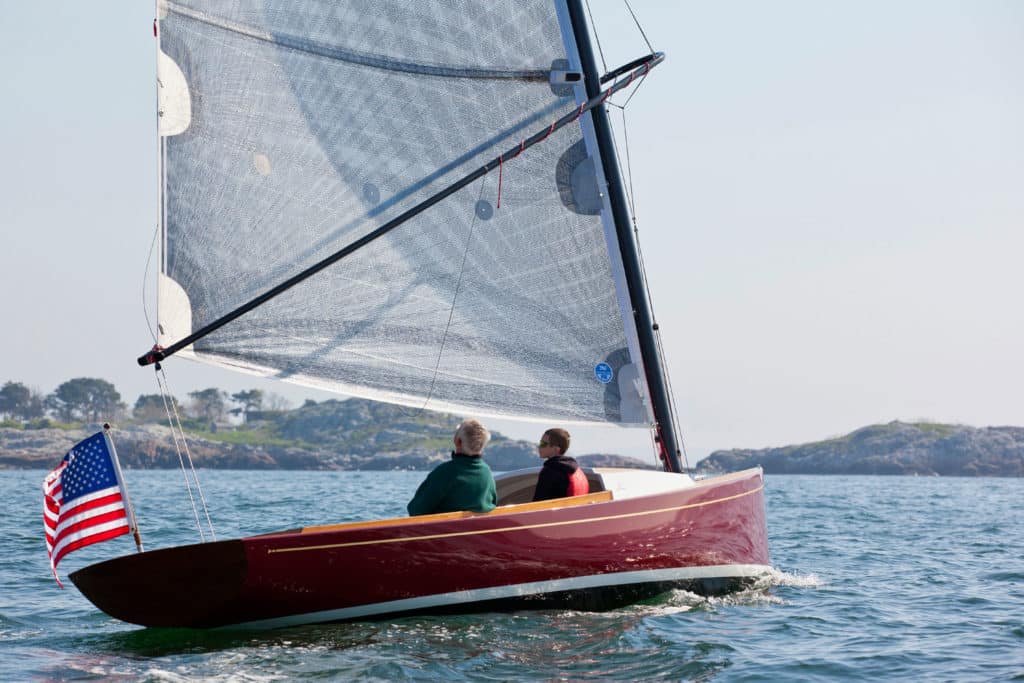
If you have an eye for elegant lines and your heart goes pitter-patter over just the right amount of overhang beneath a counter transom, the Marblehead 22 daysailer, designed by Doug Zurn and built by Samoset Boatworks in Boothbay, Maine, will definitely raise your pulse. Traditional-looking above the waterline and modern beneath, the cold-molded hull sports a deep bulb keel and a Hall Spars carbon-fiber mast with a wishbone rig and square-top main. The 11-foot-9-inch cockpit can seat a crowd, and a small cuddy forward will let you stow your friends’ gear for the day. samosetboatworks.com
Catalina 22 Sport
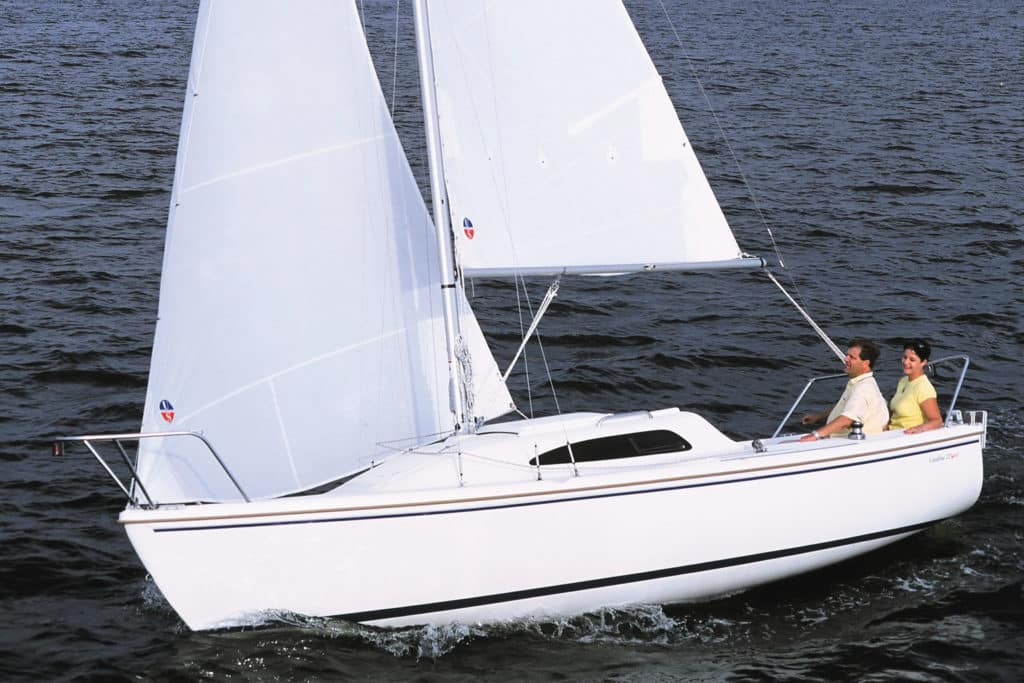
Many a harbor plays host to an active fleet of Catalina 22s, one of the most popular small sailboats over the years, given its basic amenities and retractable keel, which allows it to be easily trailered. Recently, the company introduced the Catalina 22 Sport, an updated design that can compete with the older 22s. The boat features a retractable lead keel; a cabin that can sleep four, with a forward hatch for ventilation; and a fractional rig with a mainsail and a roller-furling jib. Lifelines, a swim ladder, and an engine are options, as are cloth cushions; vinyl cushions are standard. The large cockpit will seat a crowd or let a mom-and-pop crew stretch out and enjoy their sail. It’s clear why the Catalina 22 is one of the best sailboats under 25 feet. catalinayachts.com
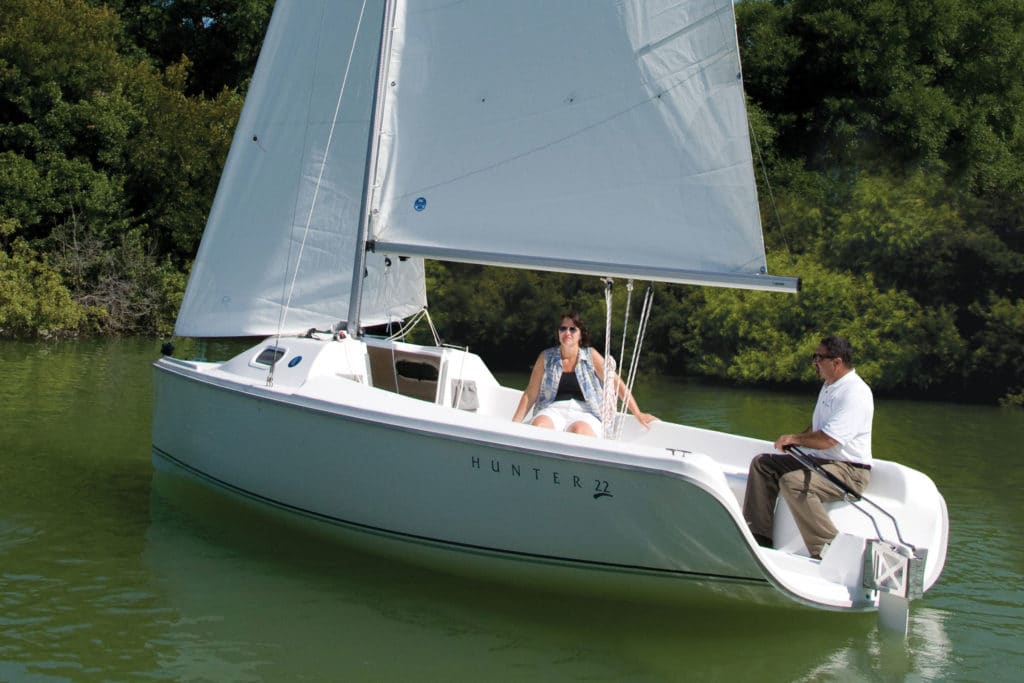
With its large, open-transom cockpit and sloop rig, the Hunter 22 makes a comfortable daysailer for family and friends. But with its cuddy cabin, twin bunks, optional electrical system, opening screened ports, and portable toilet, a parent and child or a couple could comfortably slip away for an overnight or weekend. Add in the optional performance package, which includes an asymmetric spinnaker, a pole, and a mainsheet traveler, and you could be off to the races. The boat features a laminated fiberglass hull and deck, molded-in nonskid, and a hydraulic lifting centerboard. Mount a small outboard on the stern bracket, and you’re set to go. marlow-hunter.com
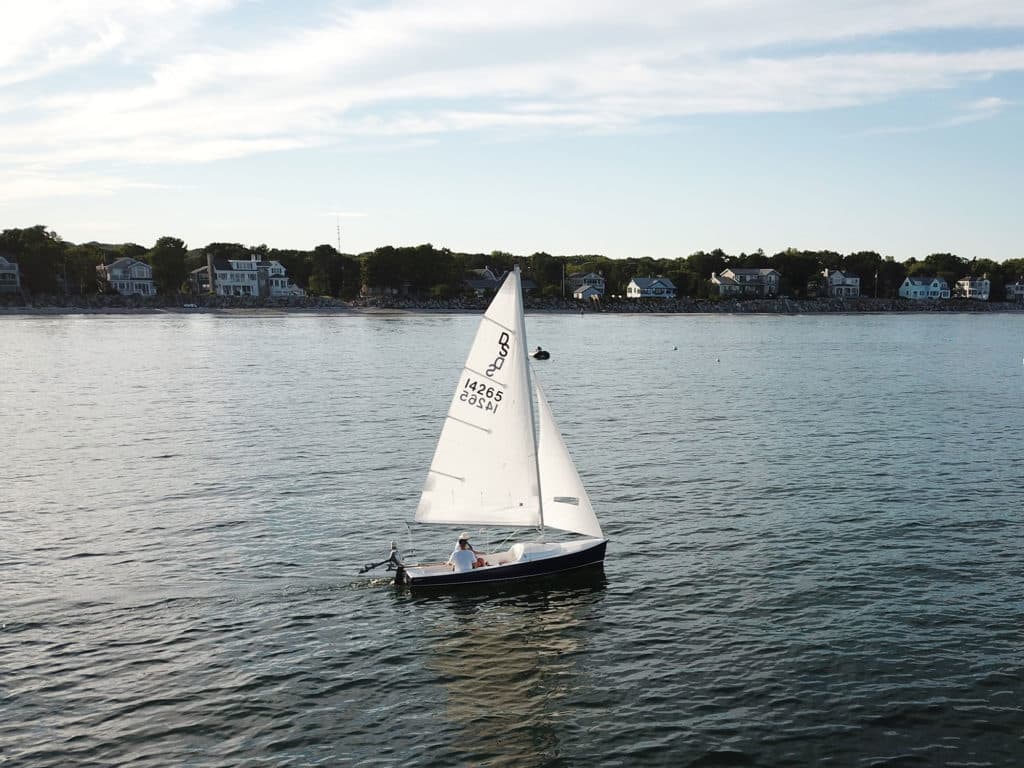
Not sure whether you want to race, cruise or just go out for an afternoon sail? Since 1958, sailors have been having a ball aboard the Uffa Fox/George O’Day-designed Daysailer. Fox, who in the 1950s was on the cutting edge of planning-dinghy design, collaborated with Fall River, Massachusetts boatbuilder O’Day Corp. to build the 16-foot Daysailer, a boat that features a slippery hull and a small cuddy cabin that covers the boat roughly from the mast forward. Thousands of Daysailers were built by various builders, and they can be found used for quite affordable prices. There are active racing fleets around the US, and new Daysailers are still in production today, built by Cape Cod Ship Building. capecodshipbuilding.com
BayRaider from Swallow Boats
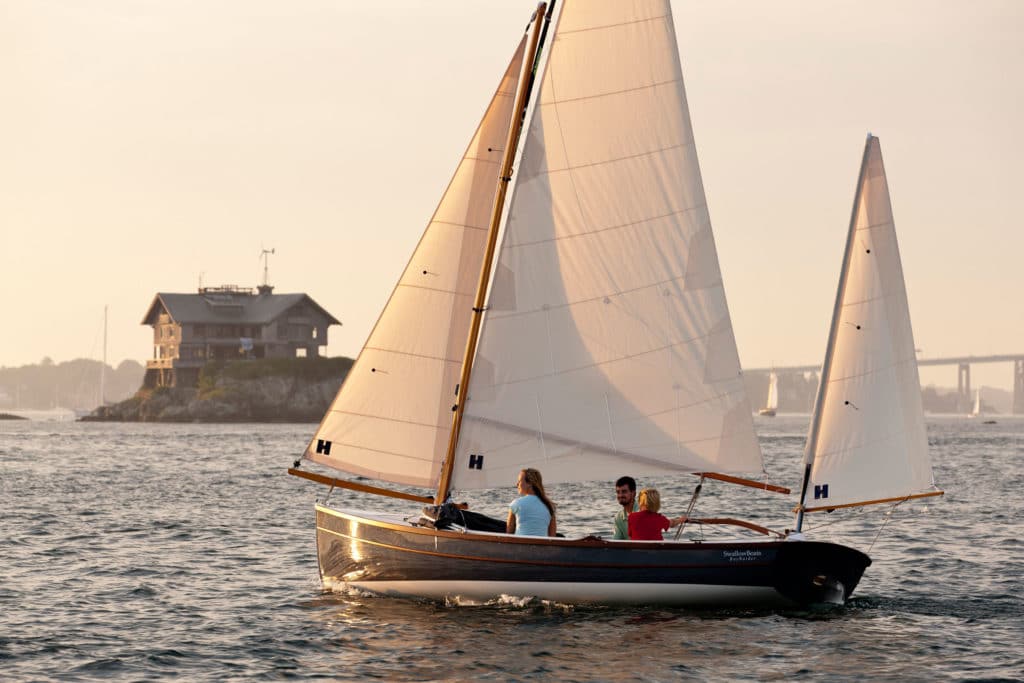
Easy to rig and trailer, the BayRaider from England’s Swallow Yachts is a relative newcomer to the small-boat market in the United States. Nearly all of its 19 feet 9 inches is open cockpit, though a spray hood can be added to keep the forward sections dry. The BayRaider is ketch-rigged with a gunter-style mainmast. The topmast and mizzen are both carbon-fiber, which is an option for the mainmast as well. The BayRaider can be sailed with a dry hull in lighter conditions or with 300 pounds of water ballast to increase its stability. With the centerboard and hinged rudder raised, the boat can maneuver in even the thinnest water.
$28,900, (904) 234-8779, swallowyachts.com
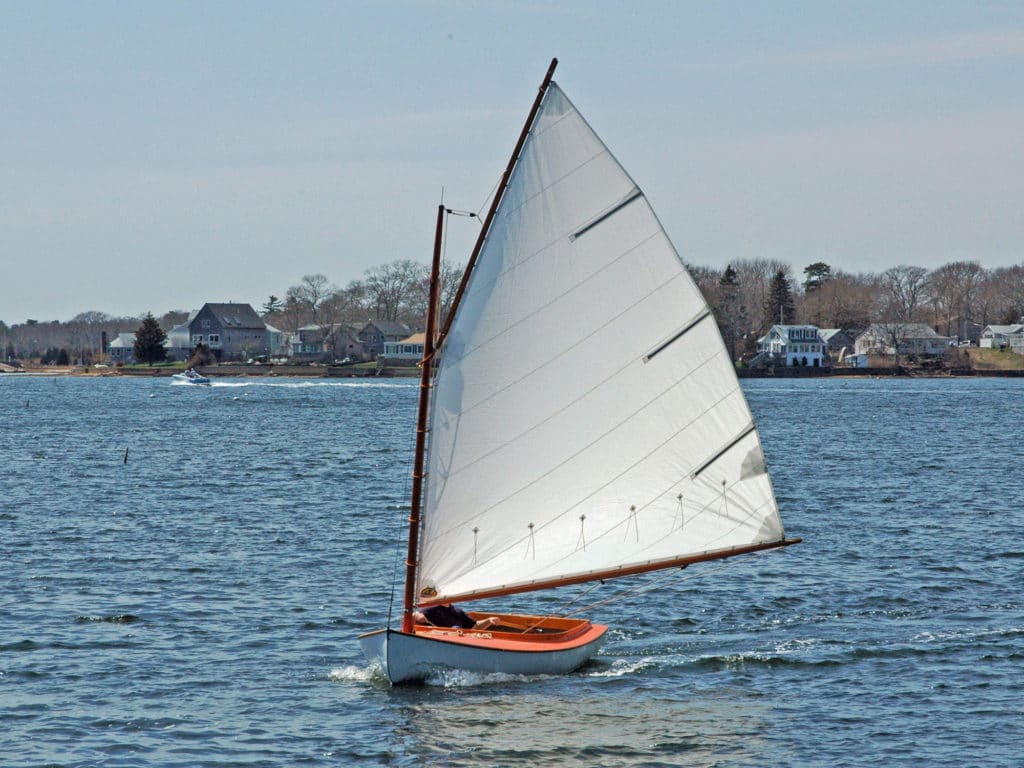
Big fun can come in small packages, especially if your vessel of choice happens to be the 12 ½-foot Beetle Cat. Designed by John Beetle and first built in 1921, the wooden shallow draft sailboat is still in production today in Wareham, Massachusetts at the Beetle Boat Shop. With a draft of just 2 feet, the boat is well-suited for shallow bays, but equally at home in open coastal waters. The single gaff-rigged sail provides plenty of power in light air and can be quickly reefed down to handle a blow. In a word, sailing a Beetle Cat is fun. beetlecat.com
West Wight Potter P 19
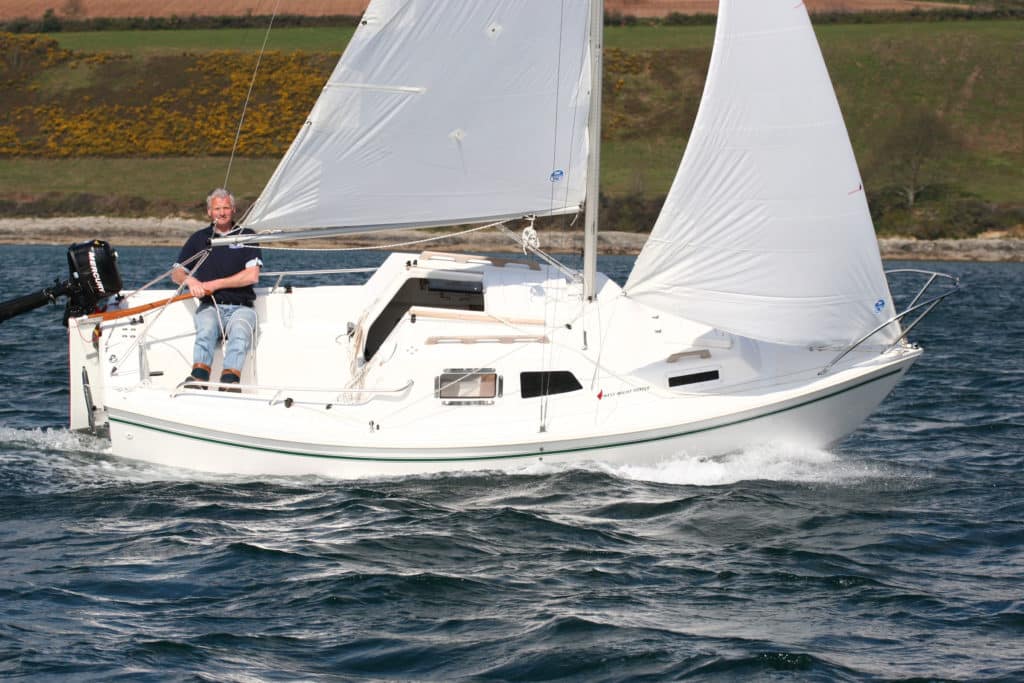
With berths for four and a workable galley featuring a cooler, a sink, and a stove, West Wight Potter has packed a lot into its 19-foot-long P 19. First launched in 1971, this is a line of boats that’s attracted a true following among trailer-sailors. The P 19′s fully retractable keel means that you can pull up just about anywhere and go exploring. Closed-cell foam fore and aft makes the boat unsinkable, and thanks to its hard chine, the boat is reportedly quite stable under way. westwightpotter.com
NorseBoat 17.5
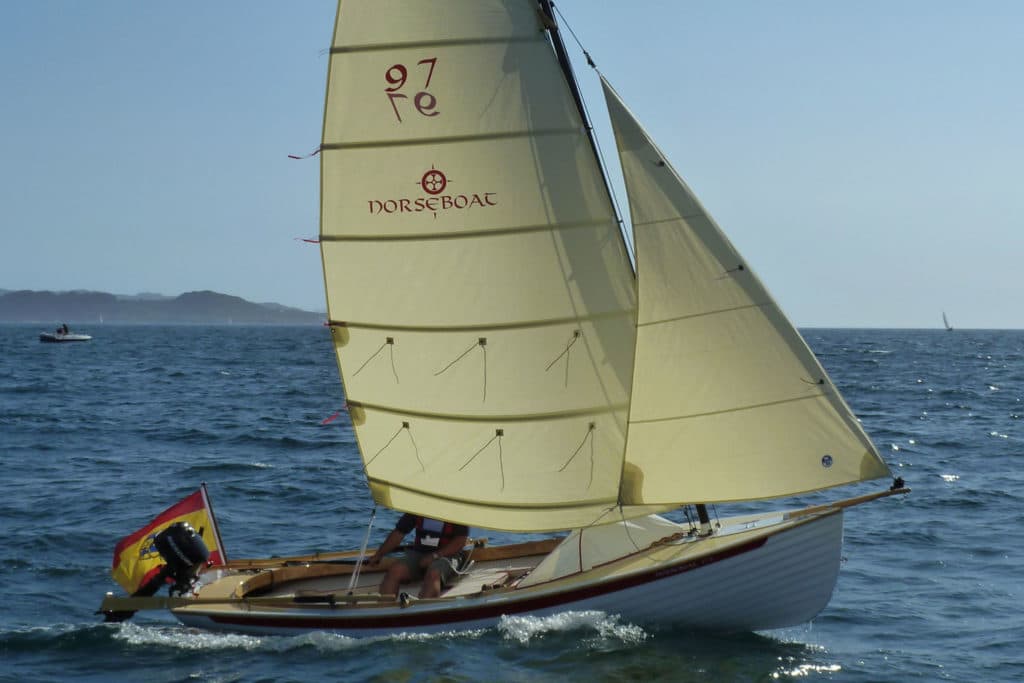
Designed for rowing and sailing (a motor mount is optional), the Canadian-built NorseBoat 17.5—one of which was spotted by a CW editor making its way through the Northwest Passage with a two-man crew—features an open cockpit, a carbon-fiber mast, and a curved-gaff rig, with an optional furling headsail set on a sprit. The lapstrake hull is fiberglass; the interior is ply and epoxy. The boat comes standard with two rowing stations and one set of 9-foot oars. The boat is designed with positive flotation and offers good load-carrying capacity, which you could put to use if you added the available canvas work and camping tent. NorseBoats offers a smaller sibling, the 12.5, as well; both are available in kit form.
$19,000, (902) 659-2790, norseboat.com
Montgomery 17
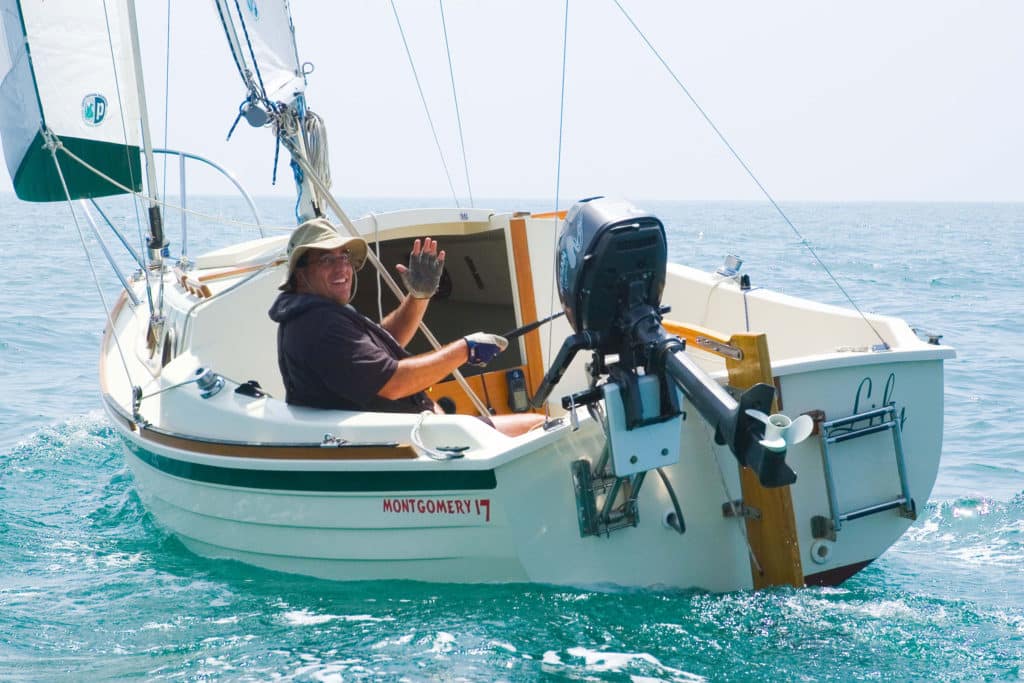
Billed as a trailerable pocket cruiser, the Montgomery 17 is a stout-looking sloop designed by Lyle Hess and built out of fiberglass in Ontario, California, by Montgomery Boats. With a keel and centerboard, the boat draws just under 2 feet with the board up and can be easily beached when you’re gunkholing. In the cuddy cabin you’ll find sitting headroom, a pair of bunks, a portable toilet, optional shore and DC power, and an impressive amount of storage space. The deck-stepped mast can be easily raised using a four-part tackle. The builder reports taking his own boat on trips across the Golfo de California and on visits to California’s coastal islands. Montgomery makes 15-foot and 23-foot models, as well. If you’re in search of a small sailboat with a cabin, the Montgomery 17 has to be on your wish list.
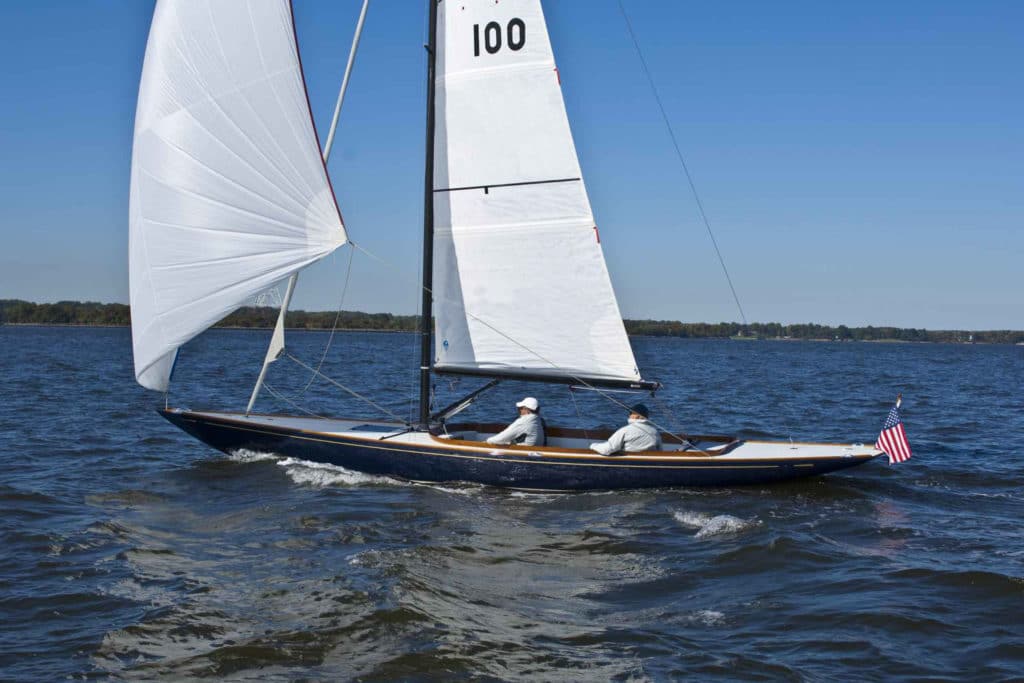
With long overhangs and shiny brightwork, the CW Hood 32 is on the larger end of the daysailer spectrum. Designers Chris Hood and Ben Stoddard made a conscious decision to forego a cabin and head in favor of an open cockpit big enough to bring 4 or 5 friends or family out for an afternoon on the water. The CW Hood 32 is sleek and graceful through the water and quick enough to do some racing, but keeps things simple with a self-tacking jib and controls that can be lead back to a single-handed skipper. A top-furling asymmetrical, electric sail drive and Torqeedo outboard are all optional. The CW Hood 32 makes for a great small family sailboat. cwhoodyachts.com
Sun Cat from Com-Pac
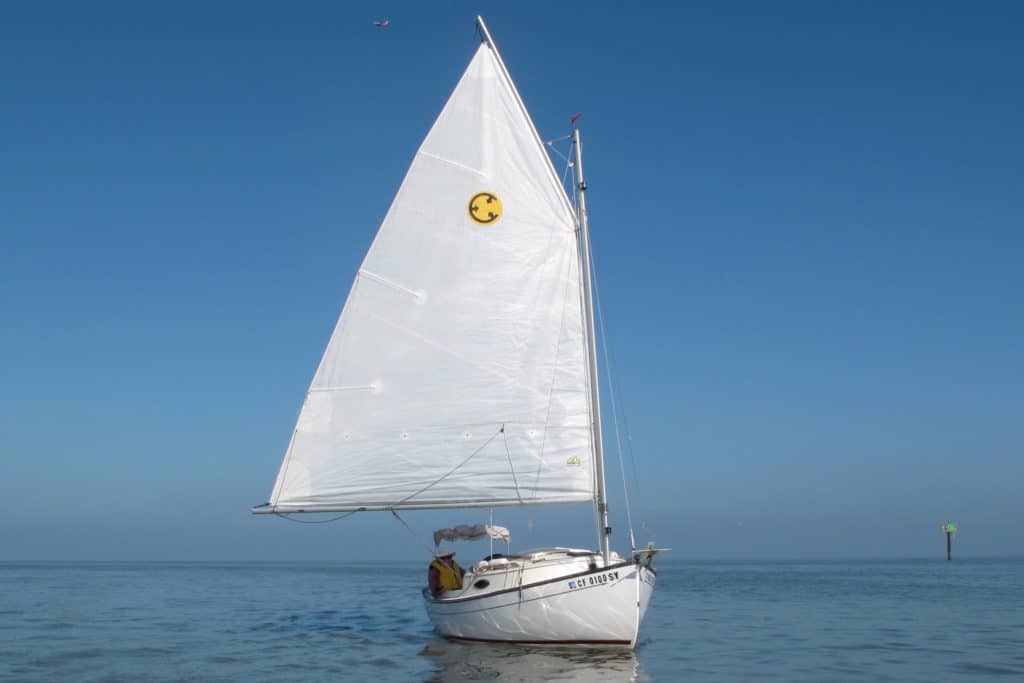
Shallow U.S. East Coast bays and rock-strewn coasts have long been graced by cat boats, whose large, gaff-rigged mainsails proved simple and powerful both on the wind and, better yet, when reaching and running. The 17-foot-4-inch Sun Cat, built by Com-Pac Yachts, updates the classic wooden cat with its fiberglass hull and deck and the easy-to-step Mastender Rigging System, which incorporates a hinged tabernacle to make stepping the mast a one-person job. If you want a personal sailboat ideal for solo sailing, the Sun Can is a great choice. Belowdecks, the twin 6-foot-5-inch berths and many other features and amenities make this cat a willing weekender.
$19,800, (727) 443-4408, com-pacyachts.com
Catalina 16.5
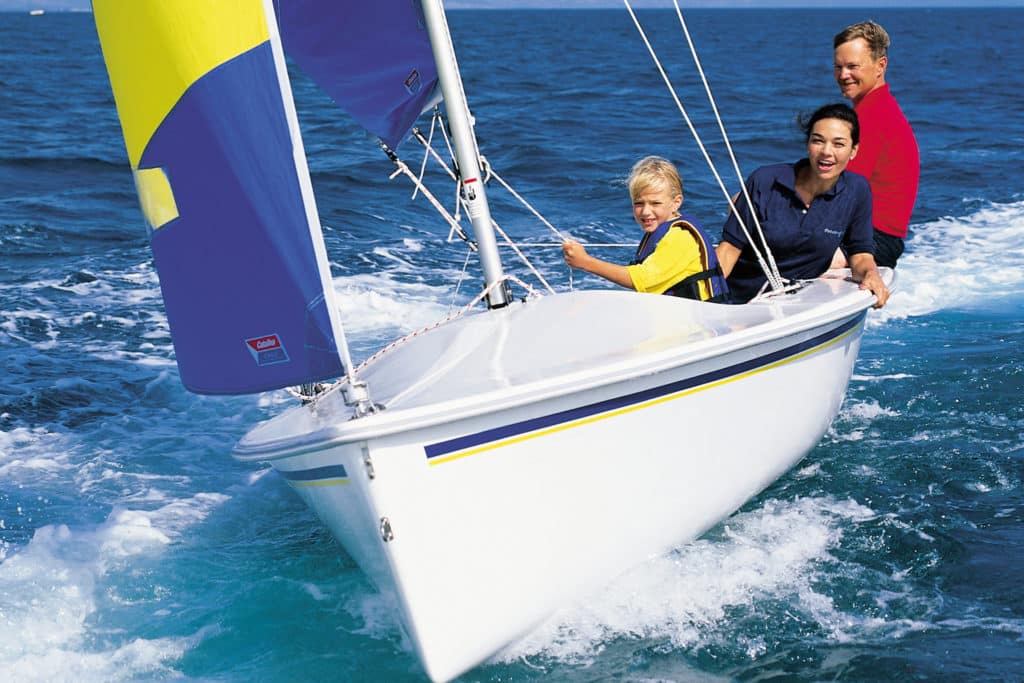
The Catalina 16.5 sits right in the middle of Catalina Yachts’ line of small sailboats, which range from the 12.5 to the 22 Capri and Sport, and it comes in both an easy-to-trailer centerboard model and a shoal-draft fixed-keel configuration. With the fiberglass board up, the 17-foot-2-inch boat draws just 5 inches of water; with the board down, the 4-foot-5-inch draft suggests good windward performance. Hull and deck are hand-laminated fiberglass. The roomy cockpit is self-bailing, and the bow harbors a good-sized storage area with a waterproof hatch. catalinayachts.com
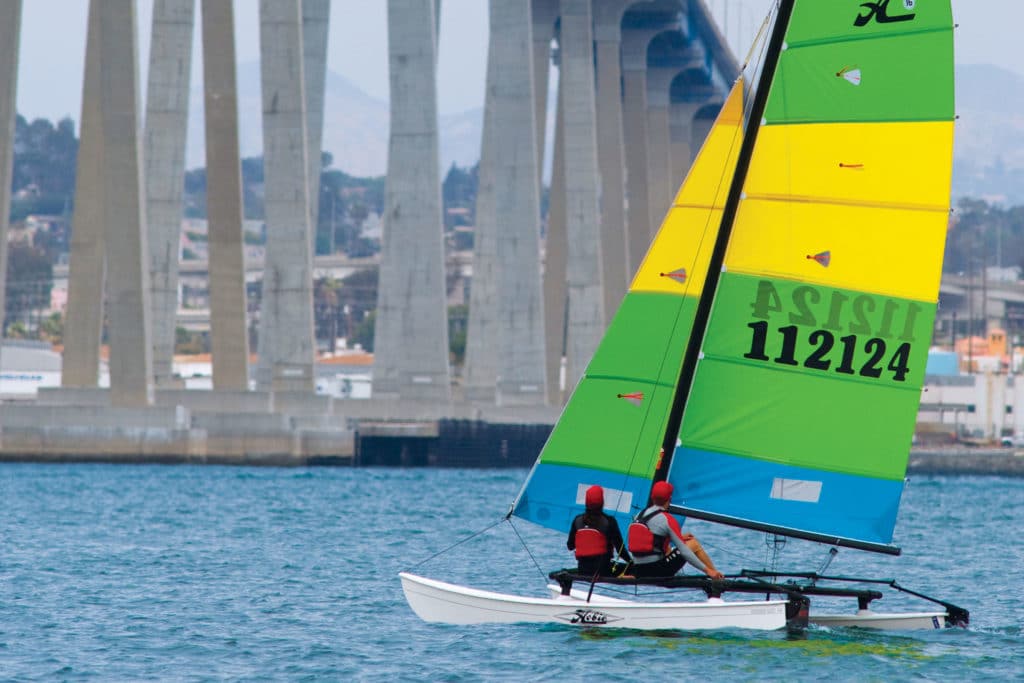
No roundup of best small sailboats (trailerable and fun too) would be complete without a mention of the venerable Hobie 16, which made its debut in Southern California way back in 1969. The company has introduced many other multihulls since, but more than 100,000 of the 16s have been launched, a remarkable figure. The Hobie’s asymmetric fiberglass-and-foam hulls eliminate the need for daggerboards, and with its kick-up rudders, the 16 can be sailed right up to the beach. Its large trampoline offers lots of space to move about or a good place to plant one’s feet when hanging off the double trapezes with a hull flying. The boat comes with a main and a jib; a spinnaker, douse kit, trailer, and beach dolly are optional features. hobiecat.com
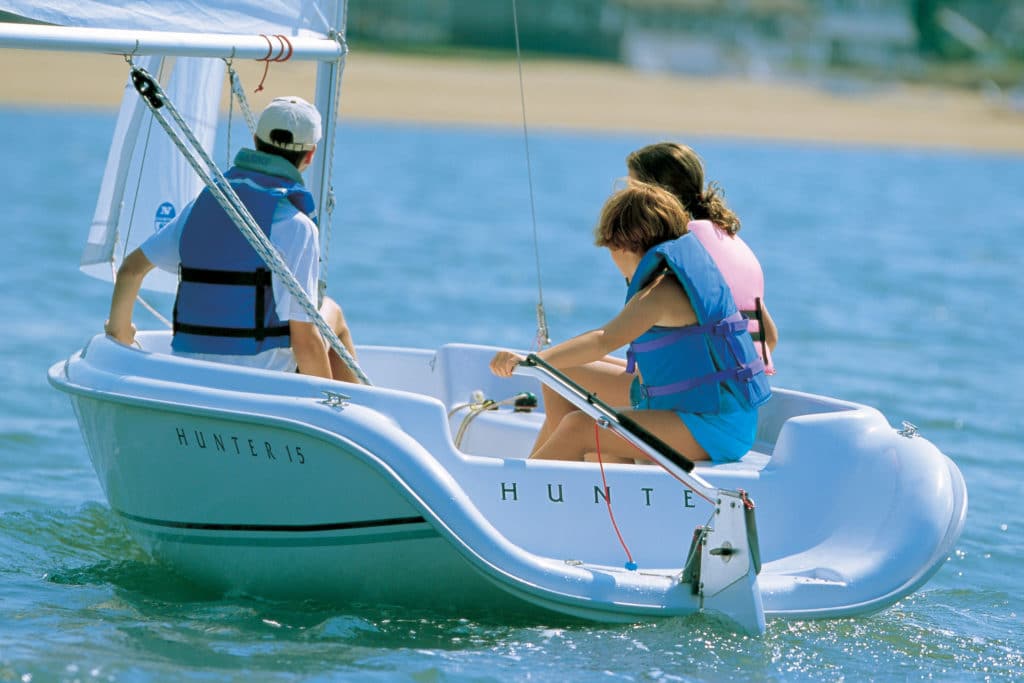
Novice sailors or old salts looking for simplicity could both enjoy sailing the Hunter 15. With a fiberglass hull and deck and foam flotation, the boat is sturdily built. The ample freeboard and wide beam provide stability under way, and the heavy-duty rubrail and kick-up rudder mean that you won’t have to worry when the dock looms or the going grows shallow. Both the 15 and its slightly larger 18-foot sibling come standard with roller-furling jibs.
$6,900/$9,500 (boat-show prices for the 15 and 18 includes trailers), (386) 462-3077, marlow-hunter.com
Super Snark
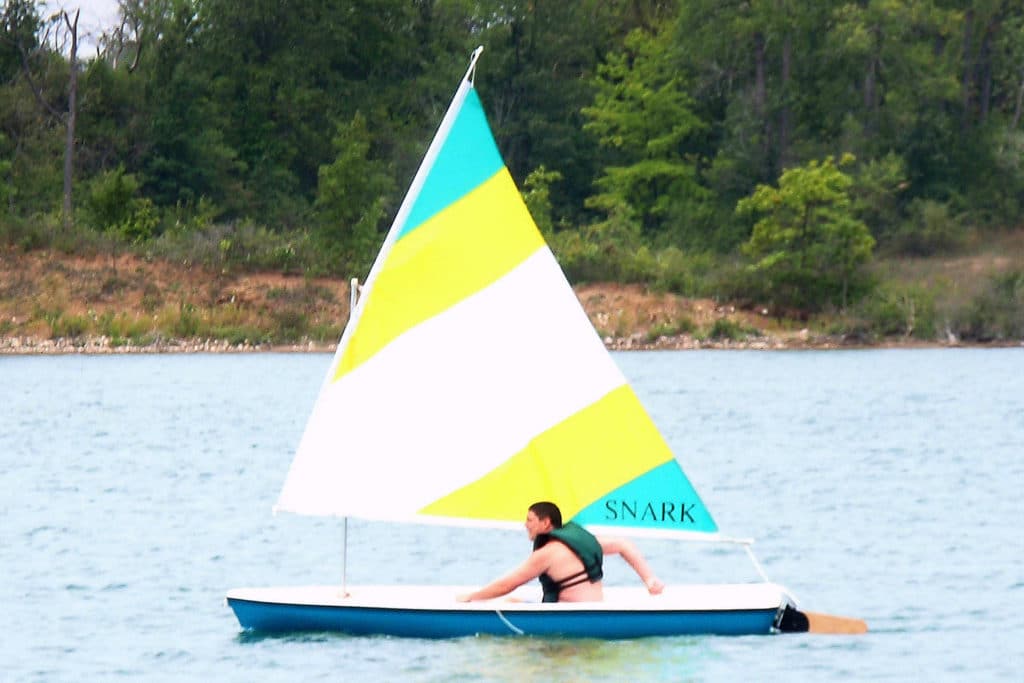
Under various owners, the Snark brand of sailboats, now built by Meyers Boat Co., has been around since the early 1970s. The Super Snark, at 11 feet, is a simple, easily car-topped daysailer that’s fit out with a lateen rig and sail. Billed as unsinkable, the five boats in the company’s line are built with E.P.S. foam, with the external hull and deck vacuum-formed to the core using an A.B.S. polymer. The Super Snark weighs in at 50 pounds, and with a payload capacity of 310 pounds, the boat can carry two.
$970, (800) 247-6275, meyersboat.com
Norseboat 21.5
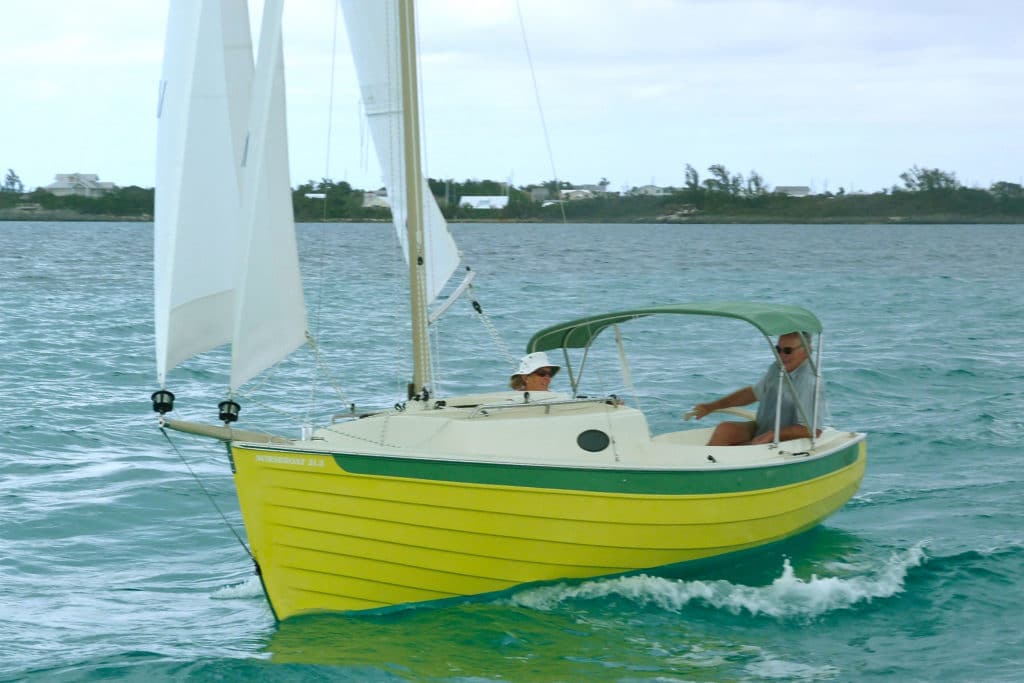
Built in Canada, the NorseBoat 21.5 is a rugged looking craft that comes in a couple of configurations: one with an open cockpit and small doghouse, and another with a smaller cockpit and cabin that houses a double berth for two adults and optional quarter berths for the kids. Both carry NorseBoat’s distinctive looking carbon fiber gaff-rigged mast with main and jib (a sprit-set drifter is optional), and come with a ballasted stub keel and centerboard. Because of its lightweight design, the boat can be rowed and is easily trailered.
$36,000 (starting), 902-659-2790, norseboat.com
Flying Scot
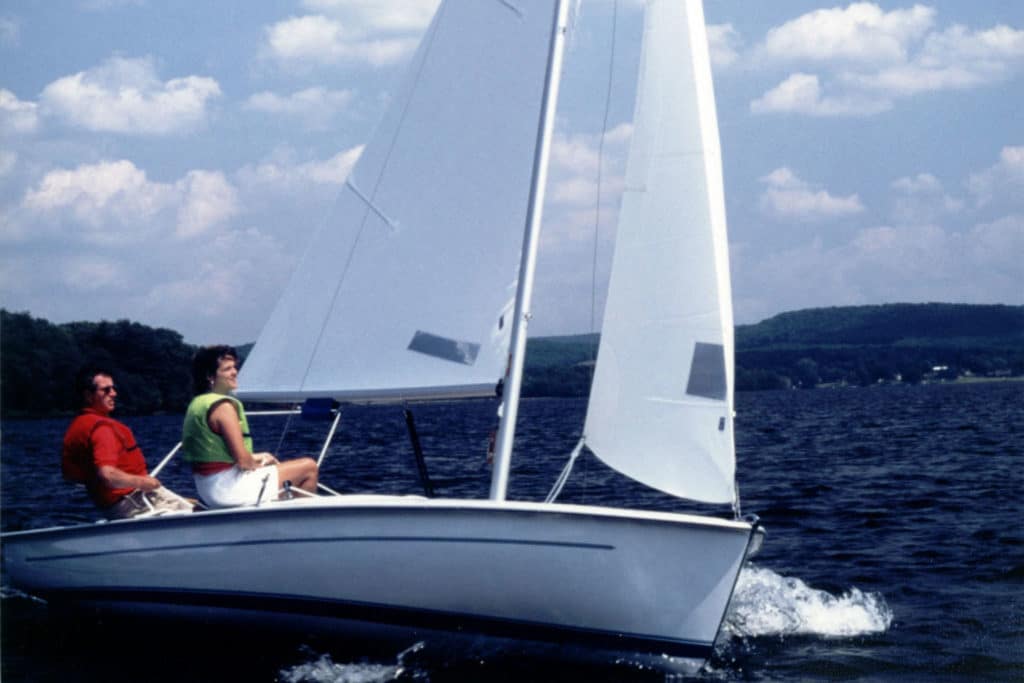
Talk about time-tested, the 19-foot Flying Scot has been in production since 1957 and remains a popular design today. Sloop rigged, with a conventional spinnaker for downwind work, the boat is an easily sailed family boat as well as a competitive racer, with over 130 racing fleets across the U.S. Its roomy cockpit can seat six to eight, though the boat is often sailed by a pair or solo. Hull and deck are a fiberglass and balsa core sandwich. With the centerboard up, the boat draws only eight inches. Though intended to be a daysailer, owners have rigged boom tents and berths for overnight trips, and one adventurous Scot sailor cruised his along inland waterways from Philadelphia to New Orleans.
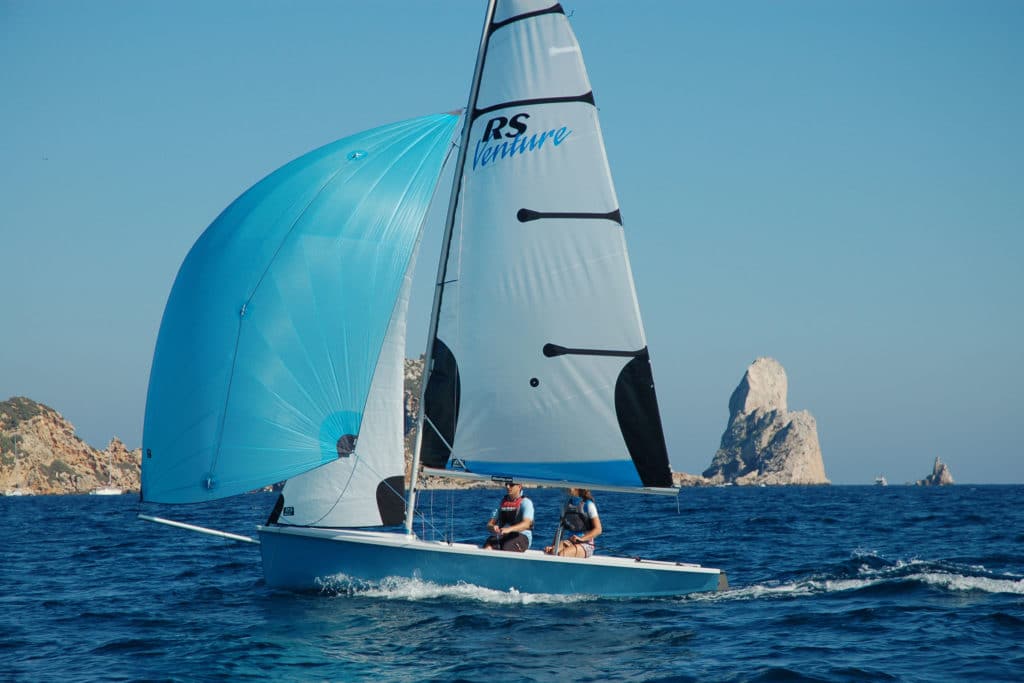
Known primarily for its line of racing dinghys, RS Sailing also builds the 16-foot, 4-inch Venture, which it describes as a cruising and training dinghy. The Venture features a large, self-draining cockpit that will accommodate a family or pack of kids. A furling jib and mainsail with slab reefing come standard with the boat; a gennaker and trapeze kit are options, as is an outboard motor mount and transom swim ladder. The deck and hull are laid up in a fiberglass and Coremat sandwich. The Venture’s designed to be both a good performer under sail, but also stable, making it a good boat for those learning the sport.
$14,900, 203-259-7808, rssailing.com
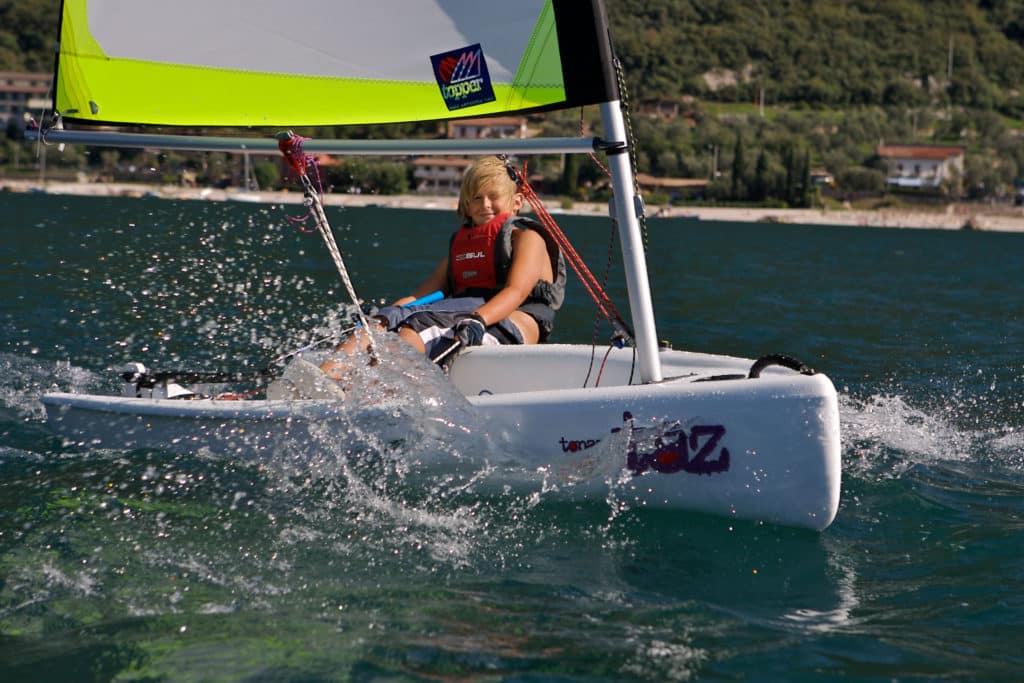
Topper makes a range of mono- and multihull rotomolded boats, but the model that caught one editor’s eye at Strictly Sail Chicago was the Topaz Taz. At 9 feet, 8 inches LOA and weighing in at 88 pounds, the Taz is not going to take the whole crowd out for the day. But, with the optional mainsail and jib package (main alone is for a single child), the Taz can carry two or three kids or an adult and one child, and would make a fun escape pod when tied behind the big boat and towed to some scenic harbor. The hull features Topper’s Trilam construction, a plastic and foam sandwich that creates a boat that’s stiff, light, and durable, and shouldn’t mind being dragged up on the beach when it’s time for a break.
$2,900 (includes main and jib), 410-286-1960, topazsailboats.com
WindRider WRTango
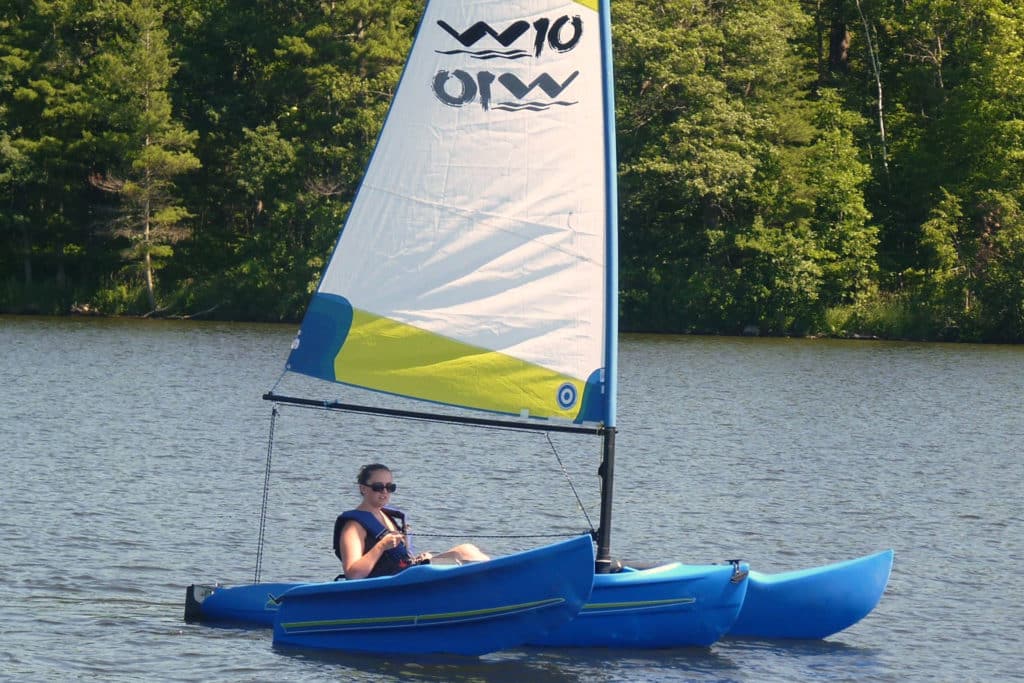
WRTango, a fast, sturdy, 10-foot trimaran that’s easy to sail, is the newest portable craft from WindRider International. It joins a line that includes the WR16 and WR17 trimarans. The Tango features forward-facing seating, foot-pedal steering, and a low center of gravity that mimics the sensation of sitting in a kayak. It weighs 125 pounds (including the outriggers and carbon-fiber mast), is extremely stable, and has single-sheet sail control. The six-inch draft and kick-up rudder make it great for beaching, while the hull and outriggers are made of rotomolded polyethylene, so it can withstand running into docks and being dragged over rocks.
$3,000, 612-338-2170, windrider.com
- More: 21 - 30 ft , Boat Gallery , day sailing , dinghy , Sailboat Reviews , Sailboats , under 20 ft
- More Sailboats

Meet the Bali 5.8

Celebrating a Classic

New to the Fleet: Italia Yachts 12.98
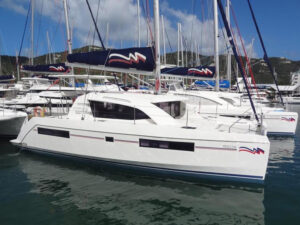
Leopard 40 Prelude Listed For Sale
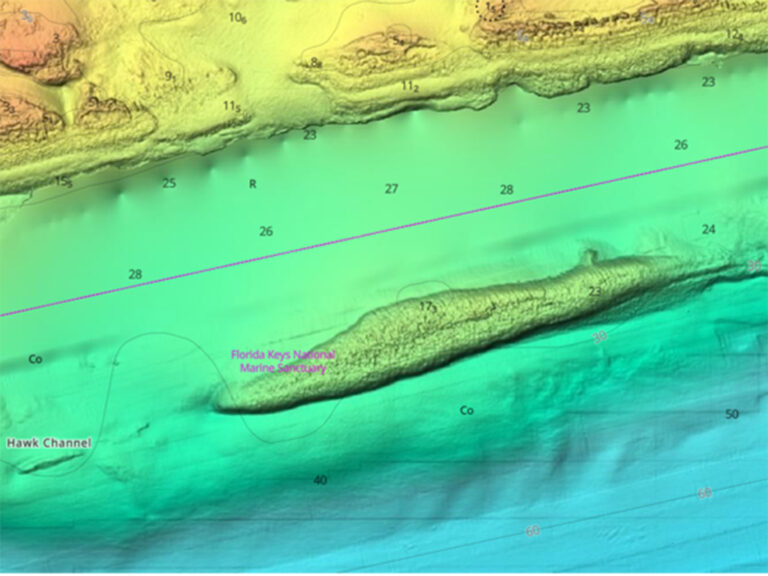
C-Map Updates North America Charts
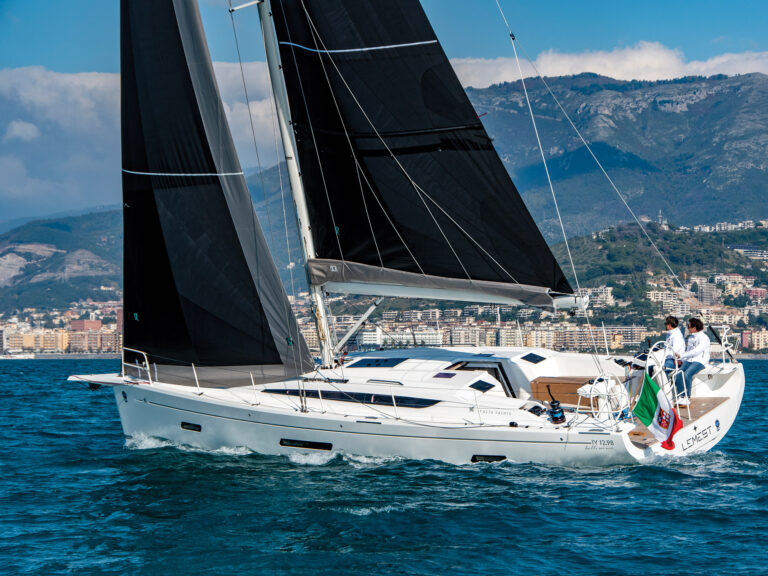
St. Vincent Court Orders Deportation For Hijacking Suspects
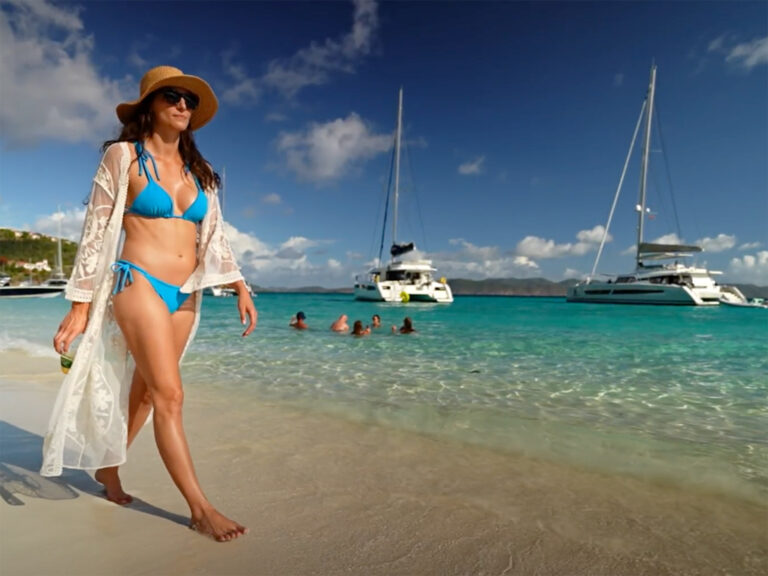
The Moorings: The Journey is the Destination
- Digital Edition
- Customer Service
- Privacy Policy
- Terms of Use
- Email Newsletters
- Cruising World
- Florida Travel + Life
- Sailing World
- Salt Water Sportsman
- Sport Fishing
- Wakeboarding
Many products featured on this site were editorially chosen. Cruising World may receive financial compensation for products purchased through this site.
Copyright © 2024 Cruising World. A Bonnier LLC Company . All rights reserved. Reproduction in whole or in part without permission is prohibited.

My Cruiser Life Magazine
What are the Best Single-Handed Sailboats and Catamarans?
Single-handed boats aren’t just limited to solo travelers. Many cruising couples will tell you that it’s a good idea to have your boat rigged and ready to be sailed single-handed. Why? What if one person gets injured—or just seasick? If your usual crew complement is only two, it makes no sense—from a safety standpoint—to require them both to be “on duty” all the time.
Of course, there are times and situations when you’ll be headed out by yourself. Maybe you like to travel but lack a consistent crew. Or many you’d just rather not bother with a crew.
The good news is that most modern cruising boats can be modified and re-rigged to improve their single-handed abilities. It all comes down to picking the right boat and making the correct modifications. Here’s a look at some of the things you’ll want to consider and five great single-handed monohull and catamaran designs.
Table of Contents
Goals for your boat, the under-rated importance of ease of single-handing, what does a single-hander need, types of autohelm, what does a single-hander want, single-handing rigging considerations, 5 great sailboats for single-handed cruisers, best single-handed sailing catamarans.
To find the perfect boat for you, whether solo or crewed sailing, is to make a list of goals and find the vessel that best meets them. There is no perfect boat. Furthermore, while you might be interested in solo sailing now, you might find yourself with a crew later on.
Start with the basics—why are you looking to single-hand your boat? Are you an adventure seeker looking to break records and find adventure with long-distance cruising? Thinking of entering a single-handed sailing race, like the Vendée Globe ?
Or are you just a solo sailor looking for a production boat that’s easy to operate by yourself? This is more common than you might imagine. Most cruising couples out there will readily admit that one member of the crew does very little to help during the actual act of sailing.
Even on two-person crews where both partners are capable, it’s often desirable for the boat to be equipped to be handled by just one person. What if one partner becomes incapacitated by seasickness—or worse, an injury? What if, even rarely, one person needs to move the boat while the other person is away?
The point is simply this—every boat that is being considered by a couple or a short-handed crew should be able to be handled by a single sailor. Whether you’re on watch while the rest of the crew sleeps or you just want to be ready for an emergency, no cruising boat should be impossible to handle alone.
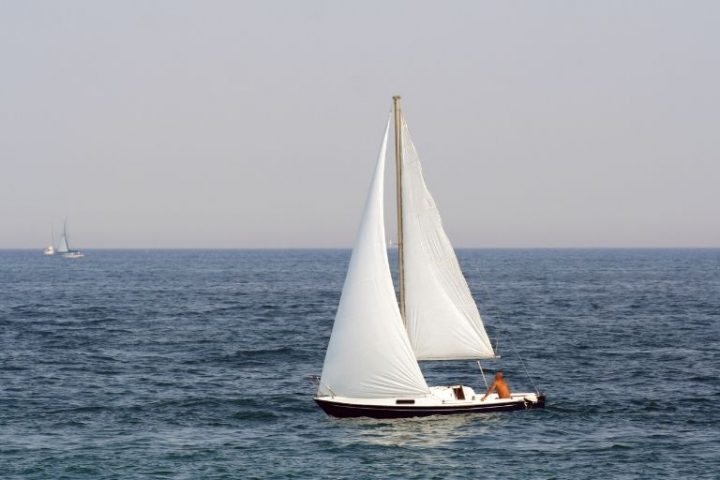
Nearly all modern cruising boats can at least be modified for easier solo handling. Here’s a look at some of the most critical gear and considerations.
The importance of each of these items will vary greatly depending on the boat, its mission, and its crew. Rigging any boat is a very personal choice. Sailors notoriously like to do things their own ways, and their boats demonstrate this character trait. The way the manufacturer or the last owner set things up is just a starting point from which you begin modifying the boat for your use.
Probably the most helpful thing to be able to single-hand is a competent hand on the helm. Thankfully, several modern and old technologies can provide solo sailors with just that.
The goal here is to allow the boat to hold a course without the operator being at the helm. Some form of “autohelm” or “autopilot” is invaluable on long passages. While it’s romantic to think of steering your ship through the dark night, in truth, it is exhausting work. An autopilot or windvane lets you relax and know that the boat will hold its course while you keep watch.
In severe weather at sea, it’s not uncommon for hand-steering crews to stand very short watches, sometimes less than an hour. This is simply due to the workload of controlling the boat in heavy weather. Some boats are more work than others, but all require more helm work when the seas are up.
This is the primary reason why the autopilot system, whatever it is, should be considered an essential part of a boat’s safety gear. A sailboat autopilot system is simply invaluable if you plan to travel far distances or do overnights on your boat.
A windvane is a purely mechanical method to controlling the boat’s heading. It has two parts—the actual windvane and then some form of steering. Many wind vanes are so well regarded as to be recognizably by brand name. Monitor and Hydrovane are probably the two most well-known models.
The windvane assembly is mounted on the transom of a vessel. The windvane itself sticks up like the rudder of an airplane, and it reacts to the wind and spins. As it spins, it uses linkages to either move the ship’s rudder or its own smaller rudder. The operator simply adjusts some small lines to select what direction the boat should be sailing from the wind. The windvane then holds that angle.
There are many advantages to these systems, and their usefulness offshore should not be underestimated. While we’re often dazzled by the digital and the new-fangled, a windvane is dead simple and offers the ultimate in reliability. It uses no battery power and requires very little input to operate. It is nothing more than metal, and short of being severely damaged or bent, there’s just not much that can go wrong with one. And one final bonus—some windvanes can be used as emergency rudders.
For all their pluses, windvanes do have some downsides. They are large and bulky, hanging off the back of the boat. And they are costly to purchase and install, too.
Electronic Autopilots
Most modern boats are equipped with at least a little bit of electronics, and autopilots are now very common. An autopilot can be described as above or below decks, depending on where the drive unit is mounted.
Regardless of the details, all autopilots work in approximately the same way. They use either a motor or hydraulic system to move some part of the boat’s rudder linkages. Some move the wheel, while others attach to an arm on the rudder shaft. Either way, the autopilot uses electronic signals to move the boat’s rudder left or right, just like moving the wheel.
Most simple autopilots are connected to an electronic compass, giving the operator a heading hold. Sailing models may also tie into the wind instruments to allow the holding of an apparent wind angle. New models that talk to the chartplotter may track navigation courses between waypoints or entire pre-planned navigation routes.
The bigger the boat, and the heavier the weather it might encounter, then the beefier an autopilot system needs to be. Autopilots can and do fail—they’re complicated electronics with a lot of moving parts. Single-handers venturing far offshore will likely want to have an entire backup unit installed or use their autopilot in concert with a manual windvane.
For boats looking to travel long distances or make overnight passages, there is no substitution for having a spare set of eyes on board. All vessels operate on the concept of “see and avoid,” meaning each captain’s responsibility to watch out for other traffic. If a single-hander is busy doing something else, like letting the autopilot drive the boat while they make their supper, who’s “on watch?”
There is only one electronic device that can be used as a second set of eyes, and that’s a good quality marine radar. All modern units allow operators to set up “guard zones.” The unit will monitor a pre-determined zone around the boat and notify you if an object is detected inside that zone.
Of course, there are other benefits to having radar on board. It can see through rain and fog. If you’re sailing solo, there’s no reason not to have a second set of eyes on board, even if they’re electronic.
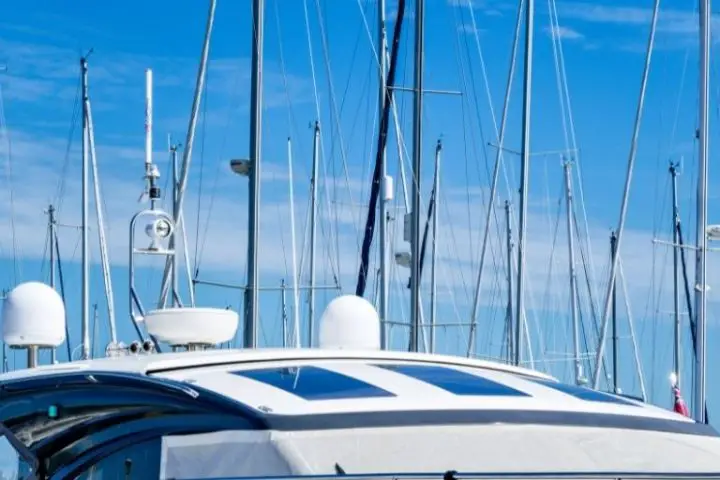
Once you’ve got a reliable autopilot and radar on board, you can move from the items you need into the items you might want. If you have an autopilot that works and you plan your actions carefully, you can likely handle any vessel without the following equipment. But these items might make it all a little more pleasant and are worth considering.
Electric Windlass and Winches
Cruising vessels that anchor regularly often have electric windlasses. These make hoisting the anchor and chain back aboard as easy as pressing a button. While manual windlasses enable you to bring up very heavy ground tackle, they take a long time to do it and require an awful lot of elbow grease.
The same applies to sailing winches on larger boats. Electric winches are complex and do take a lot of power, but they also make hoisting and handling big sails a breeze.
Line Control From the Cockpit
Pretty much every sailboat has the most crucial control lines rigged to the cockpit. Jib and main sheets are the perfect examples. But some boats go one step further, also running halyards and reefing lines to the cockpit, too.
There are plusses and minuses to this approach. Running these lines from the base of the mast aft to the cockpit increases the drag on the system, meaning it will take more effort to hoist or tighten the lines. But the security of not having to leave the cockpit if you don’t have to is worth the investment, so long as you have the rope clutches and winch power to make it all work.
Some sailors balk at the idea of running these lines aft, often citing that they’ll have to go forward if something goes wrong. But most of the time, they won’t have to. Fewer trips up on deck at sea means a safer and easier voyage all around. For the single-hander especially, the more you can do from one position, the better.
The layout of how the lines are run to the cockpit is important, too. This is often more a factor in the yacht’s design than something you can easily play with. But where applicable, a sailor will want to spend considerable time thinking about where they want to put lines and how they want to get them there.
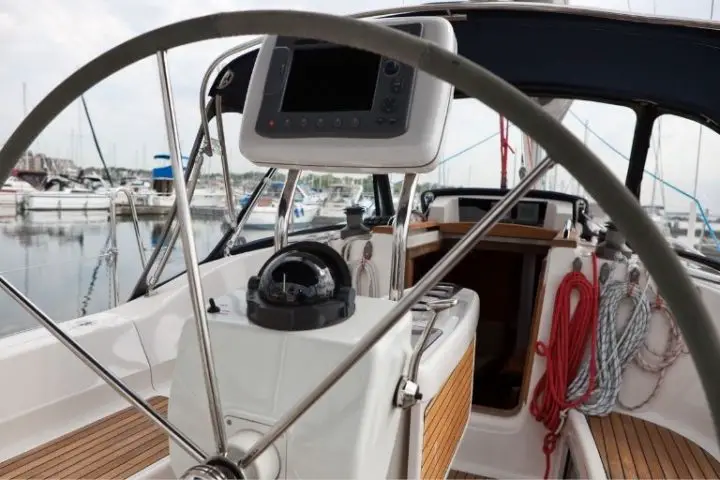
Rig Simplicity
The simpler the rig, the easier it is to sail. While nearly all production boats are sloops, the catboat has some distinct advantages here. With only one big sail to worry about, the amount of work and line handling is instantly reduced by two (or three, in the case of ketches or cutters). Catboats like the Nonsuch are known to be excellent performers and are super easy to sail. There are a few cat-rigged schooners out there, too.
There are many variations of traditional sailplans that have been played with on modern boats. Junk rigs, for example, are simple to create and very easy to sail. They’re complex in their setup and not very common on fiberglass boats, however.
If you’re looking for something easy to handle, efficient, and really wild, check out this article from Sail Magazine featuring some of the cutting-edge things found on yachts and the very interesting AeroRig.
Related: Best Trailerable Sailboats
Self-Tending Headsails
Some sloops have smaller headsails that are “self-tending.” This is another way of saying that these sails don’t need to be tacked, you can trim them like a mainsail, and you can tack the boat simply by turning the helm. That’s a considerable reduction in workload for the crew, whether they’re a single-hander or not.
Roller Furlers on Sails
Headsails can either be hanked on or rolled up on a furler. A furler means less hoisting, and you can open the sail from the cockpit. Although somewhat less common, mainsails can be furled too. Some boats have in-mast furlers. On boats with large full-batten mainsails, in-boom furlers are becoming more common.
The advantage of these systems is that they make reefing and reducing sail extremely easy. The hassle, of course, is that they have more moving parts and are expensive to install.
Cockpit Layout
The cockpit layout is about more than just the rigging. You’ll also want to take note of where and how the electronics are mounted. For example, is there a handheld VHF or do you have to go down below every time you make or answer a radio call? Are the chartplotter and radar in easy view of the helm? These are easy things to fix but worth looking at and thinking about as you set the boat up.
Easy Docking
Finally, the boat should be easy to dock single-handed. Of course, it’s always preferable to have help on the dock to get the slip safely. But this doesn’t always happen, so you should be prepared to do it yourself.
Many sailboats benefit from having a bow thruster installed, as this can help control the bow when docking in close quarters, especially in crosswind situations.
The overall size of the boat is an important factor, too. You can single hand huge yachts, which is all well and good until it comes time to dock it.
Monohulls Rigged for Easy-Operation
The good news is that you can rig nearly any boat for safe and easy single-handing. The newer the boat, the more likely it will already be set up for single-handing. Modern items like line organizers and rope clutches make it all the easier.
The boats below are exceptional in that they step away from the now ubiquitous Bermuda sloop rig. As a result, they may lose some performance abilities in some conditions, but they more than make up for it in their ease of handling.
Nonsuch 36/40
Nonsuches are distinctive boats—they are some of the only large catboats on the water today. They’re rigged with a large mainsail that is made easy to control by a wishbone boom rigging system. In effect, this makes handling a Nonsuch much like sailing a giant windsurfing board. The larger Nonsuches come from the drawing board of respected marine architect Mark Ellis.
With only one sail, the boat is straightforward to operate. First, hoist the main, and then control it with a single sheet. Tacks and jibes are easy. Reefing is as simple as letting out the halyard a little and reducing sail.
Freedom has made various interesting and straightforward rigs that contrast with the run-of-the-mill sloops found in most marinas. The number one thing you’ll notice about Freedoms is their distinctive tapered un-stayed mast. With no spreaders and no standing rigging, Freedoms look sleek from the outset.
Several models of Freedom are catboats rigged with a giant mainsail. Others, like the popular 36, are free-standing, fractionally-rigged sloops with a tiny, self-tending jib. This is the best of both worlds since the jib will provide extra power when going upwind and presents very little extra work for the crew.
Picking a catamaran for solo sailing may seem counterintuitive since they are so much larger than monohulls. But most modern catamarans are rigged from the factory for single-handed sailing. These boats are designed from the ground up for charter work—meaning that a captain will do all the work while their guests enjoy themselves. This flies in the face of the design ethos shared by most older “classic plastic” monohulls built for the club racing scene.
Most cruising catamarans are rigged with straightforward fractional sloop rigs with large, full-batten mainsails. The mains typically feature slab reefing, and the foresails are almost always mounted on furlers. Operating these boats is as simple as hoisting the main and then unrolling the jib.
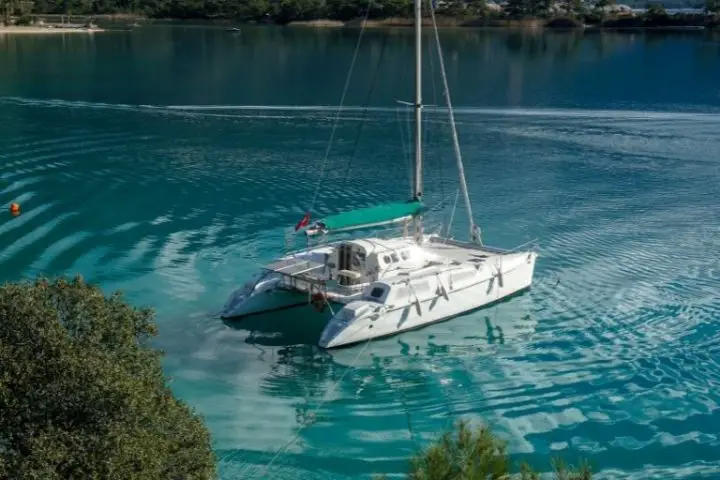
Leopard 39/40 (circa 2010)
Leopard catamarans, built by Robertson and Caine of South Africa, is the sole supplier of catamarans to The Moorings yacht charter company worldwide. But their boats are equally popular among private owners who want the catamaran lifestyle and ease of sailing.
Unlike competing brands, Leopard embraced the idea of the single-handed operator from their earliest designs. Even some of their original boats, the 38, 45, and 47 (circa 1998), had excellent walk-through helm stations with all lines led to them. As a result, you can perform every task on these boats—from hoisting the main, unfurling the jib, reefing, and even trimming the traveler—while keeping one hand on the helm.
Lagoon 39/40/42 (2015 and newer)
Lagoon is Leopard’s main competitor, but if you look at their older designs, they spent years catching up to Leopard in terms of helm positioning and single-handed operations. This changed dramatically when Lagoon introduced the 39 around 2015 and the 42 and 46 a few years later.
This new generation of Lagoons went one step better than Leopard. They have ditched the enormous and powerful mainsail in favor of a larger and self-tending jib. These boats carry their masts much farther aft than other catamarans, and the design is more similar to the Prouts of the 1990s than other modern catamarans.
But this setup makes two significant improvements. First, it reduces the power of the sometimes difficult to control mainsail. Second, it also adds self-tacking abilities to the headsail. And since most cats use furling light-wind sails for downwind and calm-day sailing, no real performance loss results.
Prout Snowgoose (circa 1987)
An older boat that is underrated these days is the Prout 37 Snowgoose. These boats featured a double headsail paired with a very small and easy to tend main. While the headsails aren’t self-tacking, they are both usually mounted on furlers. This provides a lot of sail plan options for offshore adventures. Additionally, the mast on these boats is located so far aft as to be even with the helm, meaning you can do reefing and hoisting chores without leaving the cockpit.
Matt has been boating around Florida for over 25 years in everything from small powerboats to large cruising catamarans. He currently lives aboard a 38-foot Cabo Rico sailboat with his wife Lucy and adventure dog Chelsea. Together, they cruise between winters in The Bahamas and summers in the Chesapeake Bay.
Best Small Sailboats for Beginners
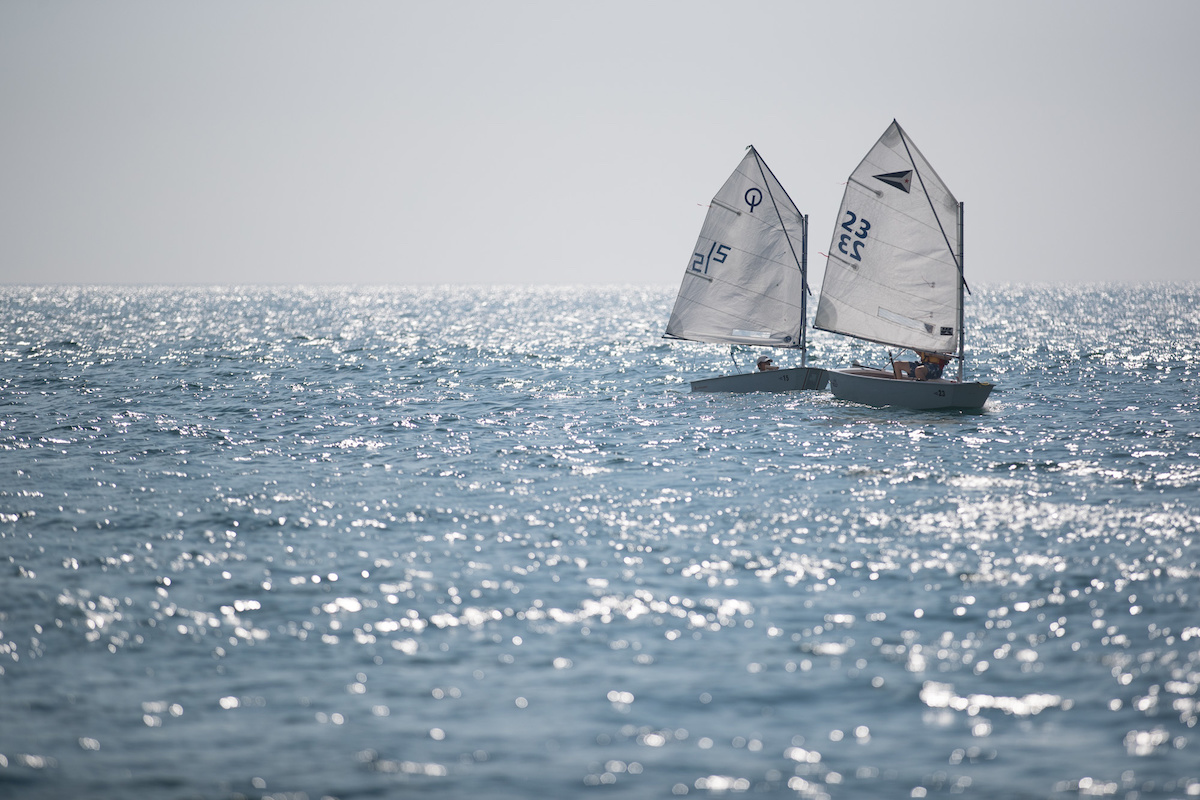
There are a number of classic trainers used by yacht club youth programs as well as techie new designs. Without mentioning specific models and brands, it’s difficult to outline which small boats are best but here are things to look for in good teaching boats.
Some of the best small sailboats for beginners include:
- Boats with tillers steering
- Boats with no winches
- Sailing dinghies
- Small sloops
- Small catamarans
- Rotomolded boats
- Trailerable sailboats
Explore All Sailboat Types
Boats with Tiller Steering
Steering by tiller (rather than a wheel) can make a difference when learning. Tillers are directly connected to the rudder that manages the boat’s direction. Tillers provide quick feedback about the strength and direction of the wind as well as the boat’s turning agility at various speeds.
Boats with No Winches
Boats that require no winches to manage the sheets and halyards are best for youngsters and new sailors. These boats usually don’t experience the same forces on the sails and rigging as larger boats, which can be a handful when the wind starts to blow. Winches are usually replaced with cam or jam cleats, which are easy to use.
Sailing Dinghies
Sailing dinghies are usually rigged with one mast and one sail and offer kids and new sailors simplicity so it’s easy to learn the ropes. Less overwhelming than boats with two sails, dinghies are light and responsive. They also have a shallow draft due to side or centerboards so they can be sailed just about anywhere. In some cases (whether from a wind gust or sudden crew weight shift) sailing dinghies can capsize so students should wear lifejackets and know how to swim. Sailing dinghies are usually sailed by one or two people.
Small Sloops
Small sloops with a mast that carries head and mainsails are the next step so students learn how sails work together. Headsails can be hanked on or attached to a small roller furler. These boats may have some or no winches, which also makes them easier to maintain. These boats can usually be sailed with one to four people.
Some sloops can scale up, providing a more challenging experience for sailors as they develop skills. Certain models can carry spinnakers and larger headsails to teach sail combinations and new sail trim techniques. Others offer the ability to hike out (shift crew weight well outboard to balance the boat against the wind pressure in the sails). This kind of sailing is more advanced.
Small Catamarans
Small catamarans provide extra stability for those who may be nervous about capsizing or aren’t fond of heeling (tipping while sailing). With two hulls providing a wide and stable base, catamarans area ideal for beginners, which may be why they’re often used by resorts as their beach sailing tourist boats. Rigged with one or two sails, small cats are tiller steered and usually have a trampoline that the students sit on and sail.
Rotomolded Boats
Small rotomolded boats are very forgiving due to their durable construction. Unlike fiberglass or wooden boats, rotomolded (a type of plastic construction technique) trainers can bounce off docks or other boats and cause or sustain little damage. Dinghies and catamarans can both be made via rotomolding.
Trailerable Sailboats
Finally, small sailboats that can be trailered to different locations add variety and that makes learning fun. Students can learn to sail in different wind and water conditions and enjoy their boats differently on vacation or with new friends.
Learning to sail involves all the senses and requires a level head and lots of practice and although it can be learned in many ways, the best way is to start with a boat that’s small, simple, safe and durable.
Read Next: Small Boats: What Are My Options?
You Might Also Like:
- Sailing Basics: 10 Nautical & Sailing Terms to Know
- Learning the Basics of Sailing
- Why Sailing?
- Find the Right Boat for Your Lifestyle
- Explore Sailboat Brands
Join Our Newsletter!
Get community news, buying bargains, and how-to guides at your fingertips.

What Sailboats Can Be Sailed By One Person? (Complete List)
We all love sailing together with friends and family, but sometimes we can’t get them to come out with us. When that happens we must sail solo. Sailing solo can be hard sometimes but if it’s just a day sail in nice weather you shouldn’t have a problem.
There are a lot of options when it comes to picking a boat for one person. More than likely, you can sail the boat you have by yourself, but if you are considering buying one and want to be able to sail it yourself, then this article will help you find one.

1. Catalina 22

I believe this is one of the best boats for first-time sailors sailing solo. Yes, this is what I started on and a lot of people do. I have had dozens of people come up to me when I was with my boat and they would tell me all about their first boat which was a Catalina 22.
They are great starter boats and very easy to handle. They may not be big enough for crossing the Atlantic, but any bay or lake sailing and they will do just fine.
The Catalina 22 comes with a swing keel, which allows you to enter those shallower waters. This makes it very convenient for lake sailing and running it up onshore. It has a draft of 5ft with the keel down and a displacement of 2,250 lbs. Another unique feature of this boat is the pop-top. Being able to pop the cabin top up a few feet increases the headroom down below. It’s a great little feature that just adds to the fun of this boat.
If you’re looking for your first boat and want to sail solo, then this is the best option in my opinion.
2. 30′ Hunter Cherubini

The 30-foot hunter is a very common sight around the docks. It is a very solid boat and easy to handle. The hull is extremely solid when well kept and great for the open ocean. I have sailed on one of these in the Gulf of Mexico and it did very well.
The last year of production was 1983, but there are still plenty of them out there. That’s because they are very well built. It has a max draft of 5.25 ft and a displacement of 9,700 lbs. It’s a heavy boat which makes it good for open oceans.
I have seen these for sale under 10K making it a great option for purchase. Depending on if you have the money of course.
3. Catalina 250

This is one of my favorite Catalina models. I love how the cockpit has extra room and the cabin still has plenty of room. It is only 25 ft long making it a great size for solo sails. If you are looking for a good weekend boat, I definitely recommend this one.
Its LOA (length overall) is 25 ft even. The draft is 5 ft with a wing keel. (click here for information on keel types) Displacement for this vessel is only 4,200 lbs. This boat will require an outboard motor for getting in and out of the docks. If you need one click here.
4. Hobie 16

The Hobie 16 has to be mentioned in this list. It is a super common boat and it is seen all over the world. There are some people that race these professionally and others that use them recreationally. They are great for kids and adults alike. If you are ever at a resort you will usually see these on the beach for rent.
The Hobie 16 has a weight of only 320 lbs making it easy to flip over when needed. With the rudder in the up position, the draft is only 10 inches. It fits up to four people, but you might be able to fit a couple more.
This boat is all about fun! Don’t sail it across the Atlantic though.
5. Catalina 36 MK II
This boat is over the average of 30 feet but that doesn’t mean you can’t solo sail it. Like I said earlier it all depends on experience. The Catalina 36 MK II is another one of my favorites. I love the size and look of it.
If you want something just a bit bigger than the 30-footers, then I recommend this one.
The draft is 5.83 ft and the displacement is 13,500 lbs. It has two cabins giving you a guest room for overnight guests. This is definitely one of my favorite boats out there. It is just a perfect size, not too big and not too small.
Just remember it is 36 ft which can get more difficult. Once you practice with it enough, you should be able to sail solo when you want. If you plan to cross the Pacific in it, it is a good size for that, but having a couple of extra hands for the journey wouldn’t hurt.
6. Macgregor 25

The Macgregor 25 is an interesting boat. The first version was called the VENTURE 25. After a few changes to the design, it became the MACGREGOR 25. With more than 7000 boats sold, it’s one of the most popular models from this builder.
I looked at one of these for purchase once but did not go through with it. I ended up with a Catalina 22. That doesn’t mean this boat isn’t right for you though. It is a tiller steering setup if that is something you are considering. I started with a tiller and I think all people should.
The draft of this vessel is 5.67 ft. The displacement is 2,100 lbs. It is not the biggest boat out there but it is still a good choice if you are just starting out and want to do some solo sails.
7. Beneteau First 27
If you have the money, this is the one for you! This new model from Beneteau is most impressive. The speed of this boat will feel like you are in the middle of a race, or more like leading the race. It is designed for speed and comfort, with sleeping up to six adults. It is also designed where a single person can sail it as well.
This boat has a displacement of 3,747 lbs and the draft is 5 feet and 7 inches. The keel is a T-bulb design, making it very unique. We all know the Beneteau brand for being luxury on the water and this one delivers in a minimalist way. Check out the video below to get a real feel of this amazing sailboat.
8. Hunter 33 Cherubini
Another Hunter sailboat for the list. This is just a little bigger than the 30-foot Hunter mentioned earlier. It is very similar and still designed by Mr. John Cherubini. The draft is 5.25 ft and has a displacement of 10,600 lbs.
The design was originally marketed by the manufacturer as the Hunter 33 but is often confused with the 2004 Hunter 33-2004, which was also sold as the Hunter 33, and the 2012 Hunter E33, which is in production as the Marlow-Hunter 33.
Hunters are always a very solid choice.
9. Laser Sailboat

The Laser is a class of single-handed, one-design sailing dinghies using a common hull design with three interchangeable rigs of different sail areas, appropriate to a given combination of wind strength and crew weight. Bruce Kirby designed the Laser in 1970 with an emphasis on simplicity and performance.
These are great boats for racing around the lake. They are very popular for racing, but can also be used for recreational sailing. Sunfish are a type of dinghy sailor very similar to lasers but are usually built for recreational only use.
10. O’Day 25

O’Day is another one of my favorites. I love their classic look and feel. This is a very popular model from the O’Day company.
The boat was built by O’Day Corp. in the United States, with 2,898 completed between 1975 and 1984, when production ended. It was one of the company’s most successful designs
The O’Day 25 is a small recreational keelboat, built predominantly of fiberglass, with wood trim. It has a masthead sloop rig, a transom-hung rudder, and a fixed fin keel or centerboard. It displaces 4,007 lbs and has a draft of 4.25 ft.
What Size Sailboat Can One Person Handle? Depends on Experience
The average size boat that most people sail solo is a 30-footer. It is very common to see people sailing by themselves or with others on this size of boat. The size is easy enough to maneuver by yourself and the sails are easy to manage when you are all alone.
This does depend on experience though. If you have never sailed before then a 30-foot boat may be too much to handle. There are a lot of things that can go wrong when sailing and not knowing how to handle them will put you in harm’s way.
There is no specific timeline that will tell you when you are ready to captain a 45-foot sailboat. It comes down to confidence. Are you comfortable sailing a 45-foot vessel by yourself? If you answered yes, then you are probably good to go, unless you are just overconfident.
Sailing certifications will usually certify you to captain a boat up to a certain length. All though you are certified you may not have the confidence still. Being confident is a huge factor. When problems come up, confidence will allow you to stay calm and resolve the issue. Don’t think you can handle anything the sea throws at you just because you have a certification.
Check out this article on sailing certifications to find out more!
Factors To Consider When Sailing Solo – General Guidance
When you are considering a boat for solo sails there are a few thoughts to keep in mind.
First, how big of a boat do you want? The bigger the boat gets the harder it is to handle by yourself. Do you want this to be a sailing solo-only boat or do you want the option to have people with you when you sail? Consider safety on the boat. If you are going to be sailing by yourself you need to make sure you have the best safety gear.
What sails are needed? The self-tacking jib may be something you want to look into. A furling jib is a minimum in my opinion. Supplies are a general category to consider. Supplies will mean spare parts in case something breaks, food and water for the trip, and anything else you might need.
Gear For Sailing Solo – Multiple Items
When it comes to sailing solo, there is some gear you may need. Check out the list below for recommendations on gear for solo sailing.
- Autopilot – When sailing out in the open ocean, the autopilot will be necessary if you ever want to sleep. It is very nice to turn it on while you take a nap or go fix something on the boat.
- Windvane – Windvanes are also great for steering when you are busy. They use wind and cabling to steer the boat. They are a great thing to have in case the autopilot goes out. Plus, if the wind vane breaks for some reason, you might have a better chance of fixing it compared to an autopilot.
- Safety Tether – These are essential for solo sailing in the open ocean. When the water gets rough, make sure you are attached to the boat so you don’t fall off. Never go on deck in rough conditions without a tether.
- Emergency Position Indicating Radio Beacon (EPIRB) – This is also an essential item when sailing around the world. One thing to make sure of is easy access. If you are in trouble you don’t want to be digging under the v-berth looking for this. Put it somewhere close to the cockpit.
- Supplies – This covers all items you may need from spare parts to canned foods. Remember to plan accordingly. Not planning is planning to fail.
These are just some of the essential items needed for multiple-day sails in the open ocean. Always plan and think about what is needed.
In Conclusion
This article discussed the different types of boats that one person can sail. My personal recommendation if you are just starting out is the Catalina 22. It was my first boat and I loved it. If you need something bigger the Catalina 250 is a great weekend boat.
If you are an average sailor look for something in the 30-foot range. That is usually a safe length that won’t get you into trouble.
As always make sure you have the gear that will keep you safe out there!
Boatlifehq owner and author/editor of this article.
Recent Posts
Sailboat Racing - Rules & Regulations Explained
Sailboat racing, a blend of skill, strategy, and adherence to intricate rules and regulations, offers a thrilling and intellectually stimulating experience on the water. Navigating through the...
What is the best sailboat to live on? Complete Guide
Embarking on the journey of living aboard a sailboat requires careful consideration of your budget, desired amenities, and storage options. This guide offers a concise, step-by-step approach to...

How to choose the best solo / single-handed sailboat?
What to consider in a sailboat for one person or a short-handed crew.
Keeping control of your yacht in all circumstances is usually on top of the list for most sailors. Because you are planning to be alone at sea, or because your crew is not necessarily savvy, or just does not intend to participate in the maneuvering and tasks, or even just wants to enjoy your RM’s interior comfort and modern cabins without being responsible for the navigation planning.
There are a few features to take into account when looking for the best solo or short-handed sailboat to live on – whether for coastal cruising or ocean crossings. If you are going to be the only one responsible for all operations, you might want to consider the yacht’s safety features, stability, easy maneuverability, and size, according to your sailing experience.
RM Yachts offers two plywood sailboats under 32 feet, which are strong, comfortable, and easy to maneuver for a single-handed sailor:
- RM 890+, liveaboard yacht of about 29-30 feet
- RM 970, a fast and comfortable 32-footer
Optimal features for safe and comfortable solo sailing
RM monohull yachts have been designed with optimized deck plans, which make them great single-handed sailing yachts: the deck fittings, the layout, the running rigging organization, and the ergonomics have been thoroughly thought to facilitate not only the solo navigation or the short-handed crew, but also the safety on board.
This ergonomics enable the single-handed sailor to:
- Have a perfect fore vision from the helm station.
- Have a panoramic vision from the inside charts table, thanks to the fore window.
- Have a direct access to the sheets and traveler, thanks to the “German sheet” display, and take action within seconds: hardening or easing, deal with gusts, etc.
This ergonomics also enables an easy task distribution: the blockers and jammers, the sails trimming, the winches at the right height for a standing crew member, etc. All this without having to run to the mast’s foot in heavy seas – ideal for a solo sailor or a person sailing without assistance.
Keep in Touch' Restons en contact
We will send you RM Yachts News (Only) to make sure you are up to date. Recevez (seulement) nos infos, pour être sûrs de ne rien rater !
- FR - Français
- EN - English
Boat Boat Go
Love Boat Party Life
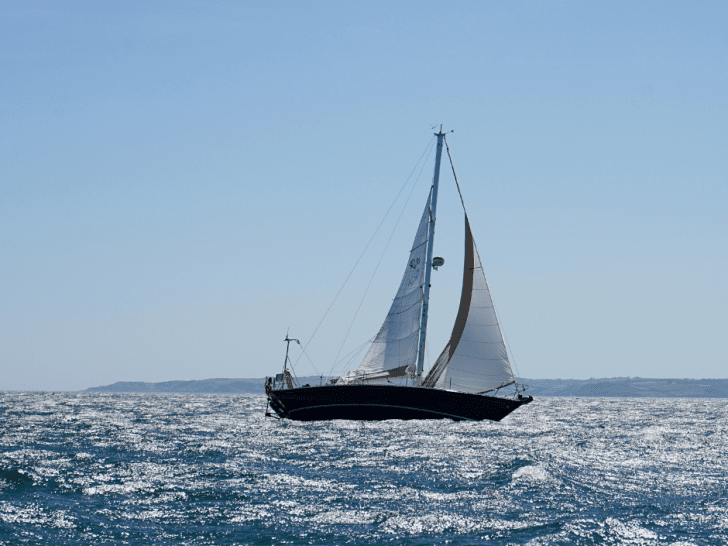
One Person Sailboat Sailing: Tips for Safe and Efficient Navigation
Sailing alone in a sailboat can be an exhilarating and rewarding experience. However, it can also be challenging, especially for those who are new to the sport. Whether you’re a seasoned sailor or a beginner, it’s important to follow certain tips to ensure safe and efficient navigation.
Table of Contents
Understanding the Basics of One Person Sailboat Sailing
Sailing a sailboat alone can be a thrilling and rewarding experience. However, it requires a good understanding of the basics of sailing to do it safely and efficiently. In this section, we will discuss the essential aspects of one person sailboat sailing.
Choosing the Right Sailboat
Choosing the right sailboat is crucial for one person sailing. It should be easy to handle and maneuver, and the rigging should be simple enough to manage alone. Some sailboats are specifically designed for single-handed sailing, while others may require some modifications to make them suitable.
A few examples of sailboats that are suitable for one person sailing are:
Weather and Sea Conditions
Understanding weather and sea conditions is essential for safe sailing. Before setting out, it is essential to check the weather forecast and sea conditions. It is best to avoid sailing in strong winds, high waves, or thunderstorms.
Here are some tips for sailing in different wind directions:
- Upwind Sailing: This includes two points of sail called close reaching and close-hauled. This is when you sail towards the path of the wind. Close-hauled is as close to the wind as you can get, just off the No-Go Zone. Your sails will have to be trimmed tightly for this to work.
- Downwind Sailing: This includes two points of sail called running and broad reaching. Running is when the wind is behind you and the sails are let out all the way. Broad reaching is when the wind is coming from behind the boat, but not directly behind you. The sails are let out slightly less than when running.
- Reaching Sailing: This is when the wind is coming from the side of the boat. There are two types of reaching: beam reaching and broad reaching. Beam reaching is when the wind is coming from the side of the boat at a 90-degree angle. Broad reaching is when the wind is coming from the side of the boat at an angle that is less than 90 degrees.
Preparation Before Sailing
Before setting sail on a one-person sailboat, it is crucial to ensure that all necessary preparations have been made. This section will cover two important sub-sections: Checking Equipment and Planning the Route.
Checking Equipment
Checking the equipment before setting sail is essential to ensure a safe and enjoyable sailing experience. Here are some equipment checks that should be performed:
- Personal flotation device (PFD): Make sure that the PFD is in good condition and fits properly.
- Sails: Check the condition of the sails and ensure that they are rigged correctly.
- Lines and rigging: Check all lines and rigging for any signs of wear or damage.
- Navigation equipment: Ensure that all navigation equipment is in good working condition, including the compass, GPS, and charts.
- Emergency equipment: Check that all emergency equipment, such as flares, VHF radio, and first aid kit, are on board and in good condition.
By checking the equipment before setting sail, the sailor can ensure that they are prepared for any situation that may arise while on the water.
Planning the Route
Planning the route is another crucial step in preparing for a safe and efficient sailing experience. Here are some factors to consider when planning the route:
- Weather conditions: Check the weather forecast and plan the route accordingly. Avoid sailing in strong winds or rough seas.
- Tide and current: Take into account the tide and current when planning the route. Sailing with the tide and current can help save time and energy.
- Navigation hazards: Identify any navigation hazards, such as rocks, shoals, or other vessels, and plan the route to avoid them.
- Distance and time: Consider the distance and time required to complete the route. Ensure that there is enough time to complete the route safely and efficiently.
Navigational Skills for Sailing
Sailing is an exciting and rewarding activity that requires a certain level of navigational skills to ensure safe and efficient navigation. In this section, we will discuss two important navigational skills for sailing: Using Nautical Charts and Understanding Compass and GPS.
Using Nautical Charts
Nautical charts are essential tools for navigation when sailing. They provide valuable information about water depths, underwater obstructions, and shoreline features. Here are some tips for using nautical charts effectively:
- Always keep the chart up-to-date by obtaining the latest edition and correcting it with the Notices to Mariners.
- Use parallel rulers and dividers to plot a course and measure distances accurately.
- Identify landmarks, buoys, and other navigational aids to help you navigate.
- Use caution when navigating in areas with shoals, rocks, or other hazards. Consult the chart for information on water depths and potential obstructions.
Understanding Compass and GPS
Compass and GPS are two important tools for navigation when sailing. They provide valuable information about direction, speed, and location. Here are some tips for understanding compass and GPS:
- Always keep the compass away from metal objects, electronics, and other sources of interference.
- Use the compass to determine your direction and make course corrections as needed.
- Use GPS to determine your location, speed, and course. Set waypoints to help you navigate and avoid potential hazards.
- Use caution when navigating in areas with poor GPS signal or interference. Consult the chart and other navigational aids to confirm your location and course.
Safety Measures for Single-Handed Sailing
Sailing alone can be a thrilling and rewarding experience, but it also comes with its own set of risks. To ensure a safe and enjoyable journey, it is essential to take the necessary safety measures. This section provides some tips on how to stay safe while sailing solo.
Personal Safety Equipment
Wearing the right safety gear is crucial when sailing alone. The following are some essential personal safety equipment that every solo sailor should have on board:
- Lifejacket : A lifejacket is a must-have safety gear for any sailor, especially when sailing alone. It can keep you afloat in case you fall overboard or encounter any other emergency situation.
- Harness and Tether : A harness and tether are used to keep you attached to the boat at all times. It can prevent you from falling overboard and help you stay safe in rough weather conditions.
- Emergency Position Indicating Radio Beacon (EPIRB) : An EPIRB is a device that sends a distress signal to rescue services in case of an emergency. It can help rescuers locate you quickly and save your life.
Emergency Procedures
Sailing alone means that there is no one else to rely on in case of an emergency. Therefore, it is essential to have a plan in place to deal with any unexpected situations. The following are some emergency procedures that every solo sailor should be familiar with:
- Man Overboard : Falling overboard is one of the most common accidents that can happen when sailing solo. The first step to take in such a situation is to stop the boat and mark the position where the person fell overboard. Then, try to retrieve the person using a life ring or any other rescue equipment.
- Fire : A fire on board can be catastrophic, especially when sailing alone. The best way to prevent a fire is to have a fire extinguisher on board and to be familiar with how to use it. In case of a fire, it is essential to extinguish it as soon as possible and call for help.
- Collision : Collisions with other boats, rocks, or other obstacles can cause severe damage to your boat and put your life at risk. In case of a collision, it is essential to assess the damage and take appropriate measures to prevent further damage.
Efficient Sailing Techniques
Mastering sail trim.
One of the most important aspects of efficient sailing is mastering sail trim. Proper sail trim can help the sailboat move faster and more efficiently through the water. The first step in mastering sail trim is to understand the different parts of the sail. The mainsail is the large sail that is attached to the mast and boom, while the headsail is the smaller sail that is attached to the forestay.
To achieve proper sail trim, the sailor should adjust the sails to the wind direction and speed. The mainsail should be trimmed so that it is parallel to the centerline of the boat, and the headsail should be trimmed so that it is parallel to the wind. If the wind speed increases, the sailor should ease the sails to prevent the boat from heeling over too much. On the other hand, if the wind speed decreases, the sailor should tighten the sails to maintain speed.
Balancing the Boat
Another important aspect of efficient sailing is balancing the boat. The sailor should aim to keep the boat level at all times to reduce drag and increase speed. To achieve this, the sailor should adjust the sails and weight distribution of the boat.
If the boat is heeling too much to one side, the sailor should adjust the sails to reduce the pressure on that side. The sailor can also move weight to the opposite side of the boat to help balance it. For example, if the boat is heeling to the port side, the sailor can move weight to the starboard side to help balance it.
In addition, the sailor should be aware of the boat’s center of gravity. The center of gravity should be kept low to reduce heeling and increase stability. This can be achieved by moving heavy objects, such as water tanks or anchors, to the bottom of the boat.
Maintenance Tips for Sailboat
Sailing a one-person sailboat can be a thrilling experience, but it also requires proper maintenance to ensure safe and efficient navigation. Here are some maintenance tips for sailboat that every sailor should follow:
Regular Inspection
Regular inspection of the sailboat is a crucial step in ensuring its smooth functioning. Here are some key areas to inspect:
- Sails: Check the sails for any signs of wear and tear. Look for holes, rips, and loose stitching. Repair or replace damaged sails as soon as possible.
- Rigging: Inspect the rigging for any signs of corrosion, cracks, or bends. Check the turnbuckles and clevis pins for tightness and wear. Replace any worn-out or damaged parts.
- Hull: Check the hull for any cracks, dents, or scratches. Look for any signs of water intrusion or soft spots. Repair any damage to the hull as soon as possible.
- Electrical System: Inspect the electrical system for any signs of corrosion, loose connections, or damaged wires. Check the battery for proper voltage and charge. Replace any worn-out or damaged parts.
Cleaning and Storage
Proper cleaning and storage of the sailboat can extend its life and prevent damage. Here are some tips:
- Cleaning: Clean the sailboat after every use. Use a mild soap and water solution to wash the deck, hull, and rigging. Rinse with fresh water and dry the sailboat thoroughly. Apply a coat of wax to protect the hull from UV rays and saltwater.
- Storage: Store the sailboat in a dry and secure location. Cover the sailboat with a tarp to protect it from the elements. Remove the sails and store them in a cool and dry place. Disconnect the battery and store it in a cool and dry place.
In conclusion, sailing a one-person sailboat can be a thrilling and rewarding experience. However, it requires proper navigation skills and safety measures to ensure a safe and efficient journey.
Related posts:
- How Fast Can A Boat Go Depending On Horsepower?
- How Far Can You Transmit with a 25 Watt VHF Radio? Explained
- Why Height Matters: Importance and Benefits of a VHF Radio Antenna
- The Legalities of Bringing Your Dog on a Boat: Understanding Local Regulations
Terms and Conditions - Privacy Policy

Builders of the Ultimate One Man Boat
Warrior One Man Boat
The ultimate one man boat - made in america, if you're looking for a one man boat, you're in the right place. if you're looking for the ultimate one man boat or the ultimate one man fishing boat, you can throw in a truck and get to the pond of your dreams, you're in the right place. if you've ever wanted to hunt or fish in an area that others can't get to, you're looking at the best one man boat for the job. hand-made, with tons of quality and spectacular design, warrior one man boats are the ultimate one man boats. lightweight, fast, sleek and sporty, these one man boats cut right through the water with virtually no sound - and they get you to that sweet spot, that honey hole where no one has been, and no one else can get to. check out the warrior one man boat online, then find a local dealer to see our incredibly well-built crafts in person., check out the 8 reasons why warrior one man boats are the ultimate one man boats, you found us, now try us out. we believe, and so do the owners of our one man boats, that our design and personalized craftsmanship is unparalleled and top of the line. continue to browse to see why, or click the dealer locator link to find the nearest dealer for warrior one man boats., tested and ready.
All Warrior One Man Boats are individually and meticulously handcrafted from a specialized hardened plastic (no rough-edge fiberglass snags). You can instantly feel the quality as you run your hand across the smooth, thick, solid surfaces. All boats are float-tested, and each weld and rivet inspected. We believe in our products. We want you to believe in them as well.
7 Models and Colors
Our seven (7) different models are all 10’ boats with various color combinations from dark brown, dark green, camo, or a combination. With fully licensed camo designs from Mossy Oak, the camouflage one man boats come with custom matching seats and matching accessory items like foot pedals, live-well covers and motor covers. All designs include our custom accessories like the quick-disconnect battery cables and built-in stainless steel motor guides.
Individually Crafted
We not only build each craft individually by hand, we inspect, float-test, and stand behind our product 100%. Our goal is to build the best one man boat in America. We want you to compare our boats with the others on the market. Don't buy another until you check these out. You will see, like we know, Warrior One Man Boats are the best one man boats made. Solid, dependable and high-quality, they're the kind of boats we would want to own. In fact, we do!
Come See Us!
We are located in South Carolina near the banks of Lake Marion, and some of the best water in the US river system, such as Black River, Pee Dee, Lynches and Santee. Our Warrior One Man Boats have been proven in the swamps of South Carolina and tested by the best outdoorsmen in the country. Check us out at a local dealer, and don't consider buying a one man boat without considering us.
A record on the high seas: Cole Brauer becomes first US woman to sail solo around the world

On Thursday, Cole Brauer made history, becoming the first American woman to sail solo nonstop around the world. The 29-year-old from Long Island, New York, celebrated at the finish line in Spain by drinking champagne from her trophy.
Friends, peers and sailing enthusiasts had been cheering Brauer on since last October, when she embarked on her more than four-month journey.
Race organizer Marco Nannini told USA TODAY he started the Global Solo Challenge to "create a platform for sailors like Cole to showcase her skills and move on to a pro sailor career."
While at sea Brauer kept her more than 400,000 Instagram followers updated − and entertained − with videos from onboard First Light. The trip was extremely challenging and physically exhausting, Brauer said in one video from December.
In the post, she describes how frustrated she felt when she had to fix and replace different parts of the boat.
"I don't want you guys to think I'm like Superwoman or something," Brauer said. "Right now I've been feeling just broken," she added, describing how she had to fix the boat's autopilot system after injuring her torso against the side of the boat's hull amid intense waves.
Who is Cole Brauer?
Brauer is from Long Island and competed for the University of Hawaii sailing team. She went to high school in East Hampton, New York, her university team website says. She was the youngest of more than a dozen sailors, or skippers, in the Global Solo Challenge.
The professional sailor lives in Boothbay, Maine, and during the spring and summer, she can be also found in Newport, Rhode Island, gearing up for races, the Newport Daily News reported last year .
Brauer has sailed on First Light, a 40-foot yacht, for over five years, the outlet reported.
"I always said I wanted to race around the world in this boat," she told the newspaper.
From above and below First Light's deck, Brauer shared aspects of her journey with followers and die-hard sailing fans.
On New Year's Eve, she donned a dress and danced at midnight , and in another post, she showed off how many pull-ups she can do.
As the only woman racing solo, nonstop around the world in the first Global Solo Challenge, Brauer said she was determined to prove there's nothing women and girls cannot accomplish.
"I push so much harder when someone's like, 'No, you can't do that,'" Brauer told NBC Nightly News . "And I'm like, 'OK, watch me.'"
Brauer is the first American woman to sail solo around the world. But Kay Cottee of Australia was the first woman in the world to accomplish the milestone, sailing off from Sydney Harbor in Australia in November 1987 and returning 189 days later.
On her profile page on the Global Solo Challenge website, Brauer said she wanted to send a message to the sailing community that it's time to leave its male-dominated culture in the past. In the profile, Brauer took aim at a lack of equal pay and what she describes as harassment in the sailing industry.
"Just as well as this community has built me up it has broken me and my fellow female teammates down. I am doing this race for them," Brauer said.
Brauer and her spokesperson did not immediately respond to requests for comment.
How long was Cole Brauer at sea?
Brauer was sailing for over four months after departing on Oct. 29.
She finished second in the race, behind a sailor who departed about a month before she did.
The start times differed because that first place boat, Phillipe Delamare's Mowgli, is much slower, Nannini said, explaining the race's staggered start times.
"The format means that if you enter on a slow, small boat you can still win, which makes it much more inclusive than an event where a bigger budget is a definite advantage," he said.
France's Delamare will win first-place prize money of 7,500 euros (about $8,140), Brauer will win 5,000 euros (about $5,430) and the third place finisher will win 2,500 euros (about $2,710), Nannini said.
How dangerous was Cole Brauer's sailing race?
A medical team including a nurse and a physician trained Brauer and sent her on her journey with medicines and medical supplies, in case of any health issues, according to her Instagram account.
Early in the race, Brauer administered her own IV with a saline solution after she became dehydrated, according to one video posted to her social media.
Brauer's most serious health scare happened in early December when she said gnarly ocean conditions caused the boat to jolt, throwing her across the inside of the boat and slamming her hard against a wall.
Her ribs were badly bruised as a result, and her medical team told her to alternate between taking Advil and Tylenol, Brauer said on Instagram.
"Rigging up a sleeping seat belt has been added to my priority list," she said in the post's caption. "I know I'm very lucky that this wasn't a lot worse."
What is the Global Solo Challenge?
The inaugural Global Solo Challenge is a nonstop sailing race in which competitors departed last year from A Coruña, Spain.
The race encompasses nearly 30,000 miles and takes place mostly in the southern hemisphere.
After leaving waters off the coast of Spain, sailors travel south and around Africa's Cape of Good Hope. The race then includes the two other capes that together make up the famous three great capes: Australia's Cape Leeuwin and South America's Cape Horn.
About half of the other competitors dropped out of the race, according to racing data posted online by the Global Solo Challenge.
Delamare finished the race late last month after embarking on his journey in late September 2023, according to race data.
Contributing: Associated Press

Best 2 Person Sailboats

Last Updated by
Daniel Wade
December 28, 2023
Key Takeaways
- 2-person sailboats are small sailboats like sailing dinghies but can be a larger boat too
- Experienced sailors will likely not need much of nay training on these boats
- Most of these boat types are trailerable sailboats since they are under 30 feet
- 2-person sailboats are some of the best sailboats but it varies on your intended use
- Consider joining a sailing club to get the most use out of 2-person sailboats
A 2-person sailboat can be a larger dinghy or a sailboat meant to be handled by two people. But what are some of the best 2-person sailboats?
The RS200, Hunter 15, and Hobie 16 are a few of the best 2-person sailboats. Other sailboats meant for two people include the Norseboat 17.5, Sunfish, and even a Laser SB3. These small sailboats are best geared as a beginner sailboat that compliments having two people on board.
In my experience, there are plenty of small sailboat brands that are perfect dinghy sailors or those that want to have an extra person on board their boat. Whether it is a big boat or small boat there are options to have at least two people on board while sailing.
Table of contents
Top 12 Best 2-Person Sailboat Brands
When people think about a two person sailboat they often refer to a small sailboat. Indeed a sailing dinghy is likely your best bet but there are other options to consider when looking for a fun cruising sailboat that can accommodate another person.
{{boat-info="/boats/rs-sailing-rs-200"}}
The RS200 is considered one of the most popular double handed dinghies in existence. Since 1995 it has become a staple for those that want to enjoy or get into dinghy sailing.
The use of two people makes it a great experience on the water and necessary to help navigate. If you have never sailed on one of these you are missing out on a thrilling experience.
{{boat-info="/boats/hunter-15"}}
One of the more affordable small sailboats best for two people out there is the Hunter 15 . It is perfect for sailors that are getting their feet wet or only go out every so often without worrying about messing with complicated features. While it can hold up to four people it is best suited for two in mind to help sail.
{{boat-info="/boats/hobie-16"}}
The Hobie 16 is one of the most famous multihull sailboats for those that enjoy a sailing dinghy. The fact that it incorporates a second person to help steer makes it a fun and rewarding experience with a friend on board. In fact having another person on board will help unlock its true sailing potential.
Norseboat 17.5
{{boat-info="/boats/norseboat-17-5"}}
For those that love a good daysailer it would be difficult to pass up a Norseboat 17.5 if you saw one for a good price. These are perfect for a couple to enjoy an evening out on the water or to gently explore shallow waters. In some cases you could enjoy fishing if the water is calmer.
{{boat-info="/boats/vanguard-sunfish"}}
The Sunfish is another classic small sailboat that is great for having two people on board. They are famous for being used in racing events across the world. They are easy to sail and are right around 14 feet in length which make them easy to transport.
{{boat-info="/boats/laserperformance-laser-sb3"}}
Laser sailboats are another iconic sailboat brand that features the ability to have two people on board. With the added weight of another person it increases the performance of this boat while racing. It is also great for building camaraderie among other sailing racers on a team.
West Wight Potter 19
{{boat-info="/boats/west-wight-potter-19"}}
West Wight Potter has made a few popular cruising sailboats over the years with most notably their 19 model. This boat is a brick house for around 19 feet and is easy to sail with another person on board. Even though these are not as fast as some of the other sailboats mentioned here it makes up for that with the added level of comfort to accommodate another guest.
Catalina 16.5
{{boat-info="/boats/catalina-16-5"}}
Catalina is known for their quality and craftsmanship of sailing yachts. There is plenty of room in the cockpit for two people to enjoy an afternoon together.
It is also a great option for a daysailer. Some of the larger models are considered a family boat but can also be used by just two people due to its ease of use while sailing.
The 420 is another edition of a sailing dinghy that is meant for two people. If you see a sailing dinghy that is not a Sunfish then this is usually the next option for sailors. It offers style and an endless opportunity to have excitement on the water.
{{boat-info="/boats/chuck-paine-paine-14"}}
The Paine 14 is considered a mini yacht and is a perfect trailerable sailboat. The boat’s design is great for accommodating another person on board. It is great for those new to sailing or want a smaller boat with a classic look.
{{boat-info="/boats/sage-marine-sage-17"}}
For pocket cruisers you cannot ignore the Sage 17 as a great option for two people on board. This fractional sloop is perfect in shoal drafts and is ideal for those that want to have a relaxing environment. It is stable and offers a great experience on the water no matter where your adventures take you.
Islander 24
{{boat-info="/boats/islander-24"}}
The Islander 24 is perfect for those that do not want a larger sailboat but also do not want a dinghy. It is a perfect blend for sailing and cruising but also providing many opportunities on the water. With its size you can easily navigate this boat with two people.
Why Are 2-Person Sailboats Great Boats?
No matter what your desired sailing adventure is there are plenty of sailboats that are geared towards an easy setup and sailing experience. For boats that are designed with two people in mind it makes it sound like it is more difficult to handle but that is not the case.
Boats that are capable for two people sailing can generally be handled by one person but the performance is improved with the addition of the second person. The type of boat will also make a difference and if it has anything equipped such as automation systems. Below are some reasons why these boats are best for beginners or those that want an easier time on the water.
Sailing is Easier
Dinghies usually are meant for racing but they offer you first hand experience on how a boat should move in the water. Do not be afraid of the occurrence of capsizing in these boats.
In fact it is an integral part of the experience that will give you real time feedback on what went wrong. As for pocket cruisers or daysailers you do not want to capsize these so make an effort to control the stability as best as you can.
Rigging Setup is Seamless
For smaller boats that you can move on a trailer they usually can be put together in pieces. This makes setting up and breaking down a simple process that is great for storage.
When you are sailing and are newer to the experience you want something that is simple while operating in real time. You will likely want to handle something that does not take rocket science to explain.
Compact Size
Bigger sailboats are a little harder to steer so that is why it is best to go for something less than 30 feet with two people. This gives you plenty of room without compromising comfort.
The most ideal size ranges for two people are between 14 and 24 feet but it largely depends on the type of boat you are using. Some sailors can even handle boats ranging 45 feet and up but it all depends on your experience and intended use.
Multiple Sails
The mainsail is all you need to learn the basics of sailing but some boats might be equipped with more sails. This might mean your boat is a sloop rig which has two sails.
If you have more sails it would not hurt to have a second person on board to help with the action of raising and lowering of them. An automation system would greatly help this situation.
Many boats have various options for steering. These include tiller and wheel steering which should be obvious when checking out the boat upon a potential purchase.
If your boat has tiller steering it is best to get a feel for how the boat is while you are sailing. However you should go for what is most comfortable to you when you are the one operating it the most.
Best for Getting Parts
Since some boats are generally smaller for two people that means it is easier to acquire boat parts for maintenance. There are more boat parts in stock for smaller boats since they are more common which means you will have less of a headache and downtime for sailing.
There might even be a good chance you can find them cheaper on a marketplace online. Some boats might be totaled at a shipyard and you can find parts cheaper than paying for new ones outright.
Best Prices
Since 2-person sailboats are generally smaller they are usually are less expensive than other larger boats. If you are able to find them used they are even better at fitting within your budget depending on that boat brand.
You can expect to pay less than $20,000 for many top quality 2-person sailboats. This all depends on the condition of the boat and how new it is upon you purchasing it. This could range much higher depending on additions to the boat and the brand.
Are 2-Person Sailboats Good for Families?
As the name suggests it would not really be ideal to have a boat that is meant to hold only two people. But some of the options mentioned above are large enough to hold roughly four people and are great for the family.
Depending on how you intend to use your sailboat can make a difference as well. Some boats can still be considered family boats if they are commonly used within the family.
What Size is Best for 2-Person Sailboats?
Depending on the activity you are going to experience on the water will affect what size boat you are needing. For sailing dinghies those are usually used for racing since speed is priority.
If you are wanting to cruise without having too much else going on then something around 25 feet would be great. Families that are wanting a little more room but still be able to handle the boat with two people can likely find sailboats ranging up to 45 feet that are easy to sail.
There is not really a science that points to the perfect length for 2-person sailing. This all comes down to how confident you are in your sailing abilities and how easy it is to operate the boat in comfortable conditions.
Features to Consider on 2-Person Sailboats
For most one or two person boats there are a handful of features that can make your life easier while sailing. The good news for most 2-person sailboats is that they can likely be operated by one person.
Any added features or design of the boat might make an impact if the other person on board is not used to the setup. Here are some added features that will make a difference but keep in mind that they might not accommodate a small sailboat like a racing dinghy.
System Automation
There are plenty of automatic conveniences to add to your boat. These include autopilot and an electric windlass. A roller furling or even a radar can also make a huge impact to your sailing adventure.
A lot of these features come in handy when the weather turns rough or the tide becomes fierce. It is also great to have these if the other person on board with you is new to sailing or is a small child.
Having a boat equipped with GPS is another option for automation even if you think you know your way around the area. Consider adding one to your boat if you plan on taking it out in moderate conditions that might take you off of the intended path.
Multihulls by default are some of the safest sailboats out there due to their stability. This is true but it also depends on the design of the boat and how it is being used.
Most 2-person sailboats are going to have great stability. If it is a small sailboat that is equipped with a lateen rig it will likely have slightly better stability than other racing dinghies. However pocket cruisers are designed to be more stable and are great for two people wanting to enjoy a cruise.
In the event that something happens you should have a safety tether or a life jacket while on board. Even with two people on board you might not be immune to falling off your boat if the conditions get rough. You should also consider having an emergency radio and a way to ping your location in case things to go bad.
Types of Sails
The sail area on a boat makes a big impact on the performance. This is also why getting the right sails are important.
You should aim to have a combination of a gaff sail and a bermuda sail to optimize performance. Both of these together if applicable are the perfect blend for many windy conditions.
Rigging Setup
There are numerous types of rigs to consider on your boat. A lateen rig has a different shape than a gaff rig and will affect the performance based on the wind.
A gaff rig is best for one or two people on board due to it being easier to sail with an easier set up. No matter what rig setup you have you should know how to properly set up the sails and safely operate while in motion.
Related Articles
I've personally had thousands of questions about sailing and sailboats over the years. As I learn and experience sailing, and the community, I share the answers that work and make sense to me, here on Life of Sailing.
by this author
Best Sailboats
Most Recent

Affordable Sailboats You Can Build at Home
September 13, 2023

Best Small Sailboats With Standing Headroom
Important Legal Info
Lifeofsailing.com is a participant in the Amazon Services LLC Associates Program, an affiliate advertising program designed to provide a means for sites to earn advertising fees by advertising and linking to Amazon. This site also participates in other affiliate programs and is compensated for referring traffic and business to these companies.
Similar Posts

Best Bluewater Sailboats Under $50K

Best Blue Water Sailboats Under 40 Feet

Which Sailboats Have Lead Keels?
June 20, 2023
Popular Posts

Best Liveaboard Catamaran Sailboats

Can a Novice Sail Around the World?
Elizabeth O'Malley
June 15, 2022

4 Best Electric Outboard Motors

How Long Did It Take The Vikings To Sail To England?

10 Best Sailboat Brands (And Why)
December 20, 2023

7 Best Places To Liveaboard A Sailboat
Get the best sailing content.
Top Rated Posts
Lifeofsailing.com is a participant in the Amazon Services LLC Associates Program, an affiliate advertising program designed to provide a means for sites to earn advertising fees by advertising and linking to Amazon. This site also participates in other affiliate programs and is compensated for referring traffic and business to these companies. (866) 342-SAIL
© 2024 Life of Sailing Email: [email protected] Address: 11816 Inwood Rd #3024 Dallas, TX 75244 Disclaimer Privacy Policy

IMAGES
VIDEO
COMMENTS
In this article, I talk about single-handed sailing and look at the nine best sailboats for one person, ranging from small lake dinghies all the way to comfy cruisers capable of oceanic crossings. Here are the best sailboats for solo sailing. RS Aero. Jeanneau Sunfast 3200. Beneteau Oceanis 62.
Catalina 315. nwyachting. This is a nifty pocket cruiser that raises the quality bar for solo sailors with extreme comfort and performance. With just a 9.45 meter hull, the Catalina 315 has more internal room than most classics and remains superb for solo sailing.
Hallberg Rassy 352. This is a sturdy and high-quality sailboat built between 1978 to 1991. It features a progressive design, combining a walk through with the aft-cabin from the main saloon. It is made with a tall and standard rig each supported on double and single spreaders, respectively.
The Hunter Channel 31, J/109, and West Wight Potter 19 are great budget-friendly, single-handed sailboats. Moving up in price, you can look at Hanse 371, Jeanneau Sunfast 3200, and even a Dehler 29. Depending on the size and the amount of features it has will determine what they are worth.
The split backstays, for example, are excellent for balance and functionality. This is one of the key reasons it was named the 2013 Boat of the Year Best Inshore Cruiser by Cruising World. The boat might surpass your needs when sailing solo, as it is a high-end sailboat with a price tag of more than $175,000.
Catalina 16.5. jlodrummer. Catalina Yachts are synonymous with bigger boats but they have some great and smaller boats too such as Catalina 16.5. This is one of the best small sailboats that are ideal for family outings given that it has a big and roomy cockpit, as well as a large storage locker.
The boat is designed with positive flotation and offers good load-carrying capacity, which you could put to use if you added the available canvas work and camping tent. NorseBoats offers a smaller sibling, the 12.5, as well; both are available in kit form. $19,000, (902) 659-2790, norseboat.com.
The Melges 14 is a versatile sailboat that is designed for solo sailing. This small, lightweight sailboat is easy to handle and is perfect for beginners. The Melges 14 is designed for racing, but can also be used for recreational sailing. It is known for its speed and agility, and is a great choice for sailors who want to experience the thrill ...
Some popular catamarans for one person sailing include the Hobie Wave, Nacra 15, and the A-Class Catamaran. These boats are designed to be fast and stable, making them perfect for solo sailing adventures. Key Features to Consider in a One Person Sailboat. When choosing a one person sailboat, there are several key features to consider.
Lagoon 39/40/42 (2015 and newer) Lagoon is Leopard's main competitor, but if you look at their older designs, they spent years catching up to Leopard in terms of helm positioning and single-handed operations. This changed dramatically when Lagoon introduced the 39 around 2015 and the 42 and 46 a few years later.
Small Sloops. Small sloops with a mast that carries head and mainsails are the next step so students learn how sails work together. Headsails can be hanked on or attached to a small roller furler. These boats may have some or no winches, which also makes them easier to maintain. These boats can usually be sailed with one to four people.
For almost 20 years, we've called this awards program SAIL Best Boats, but this year, we're refining and renaming this program to better and more fairly represent the boats we've selected. Restricting boats to categories and labels—such as Best Cruising Monohull 30-40 feet and Best Performance Monohull 40-50 feet—doesn't bring our readers the full picture.
The Hobie 16 has a weight of only 320 lbs making it easy to flip over when needed. With the rudder in the up position, the draft is only 10 inches. It fits up to four people, but you might be able to fit a couple more. This boat is all about fun! Don't sail it across the Atlantic though. 5. Catalina 36 MK II.
One of the most important factors to consider when choosing a one person sailboat is the size of the boat. Generally, one person sailboats range from 10 to 30 feet in length. Smaller boats are easier to maneuver and handle, while larger boats provide more space and stability. Rigging. The rigging of a sailboat refers to the system of ropes ...
The Baba 30 also offers a nice extra perk. According to Jack Hornon, she "continues to have one of the highest resale values of any boat of this type and size.". A quick look at Yacht World reveals Baba 30s from the mid-70s and mid-80s typically cost anywhere between $20,000 and $70,000.
The Wayfarer is probably one of the best known dinghies for cruising inland or on the coast and can also be used as a training boat, or raced with a spinnaker. The GP14 can likewise be used for cruising or racing (the class held its 2016 world championship in Barbados) and has a vibrant calendar covering both aspects of the sport.
There are a few features to take into account when looking for the best solo or short-handed sailboat to live on - whether for coastal cruising or ocean crossings. If you are going to be the only one responsible for all operations, you might want to consider the yacht's safety features, stability, easy maneuverability, and size, according ...
Well, a sailboat measuring between 35 and 45 feet (10.5 - 14 meters) with a draft of about 2 meters, plenty of sail area, easy reefing, and well-working assistive equipment can be ideal for one person to handle. The boat shouldn't be over 9 tons as things can get a little tricky and out of hand if the boat exceeds this weight.
1. Twelve of the best training boats Sailing schools, clubs and training centres use a variety of boats with beginners, including singlehanders such as the Pico, Hartley 10 and the RS Quba, the latter having three rigs catering from entry level to more experienced sailors. There's also a range of larger training dinghies from builders such as RS, Topper, Laser and Hartley Boats.
It is best to avoid sailing in strong winds, high waves, or thunderstorms. Here are some tips for sailing in different wind directions: Upwind Sailing: This includes two points of sail called close reaching and close-hauled. This is when you sail towards the path of the wind. ... Sailing a one-person sailboat can be a thrilling experience, but ...
Tested and Ready. All Warrior One Man Boats are individually and meticulously handcrafted from a specialized hardened plastic (no rough-edge fiberglass snags). You can instantly feel the quality as you run your hand across the smooth, thick, solid surfaces. All boats are float-tested, and each weld and rivet inspected. We believe in our products.
Popular one-design sailboats include Laser, 49er, I-420, and Ideal 18. Some popular multihull one-design boats are A-Cat, Isotope, and Hobie 16. Various one-design boat brands will cater to specific races and sailor's needs in order to provide the best experience. In my experience the Laser is one of the popular one-design brands in existence ...
A record on the high seas: Cole Brauer to be first US woman to sail solo around the world. In a sea of male competitors, Cole Brauer is the only woman in an around-the-world solo sailing ...
The RS200, Hunter 15, and Hobie 16 are a few of the best 2-person sailboats. Other sailboats meant for two people include the Norseboat 17.5, Sunfish, and even a Laser SB3. These small sailboats are best geared as a beginner sailboat that compliments having two people on board. In my experience, there are plenty of small sailboat brands that ...